Paul van Yperen's Blog, page 336
August 20, 2016
Gunnar Tolnaes
Norwegian-born actor Gunnar Tolnaes (1879-1940) conquered the Danish film market in the middle of the 1910s. His most famous performance was an Indian prince in the Danish Orientalist melodrama Maharadjahens Yndlingshustru/The Maharaja's Favourite Wife (1917). It was so popular that it had a Danish sequel in 1919, and a German sequel in 1921. During the 1920s Tolnaes alternated acting in Danish films with roles in German productions, until the end of the silent era.
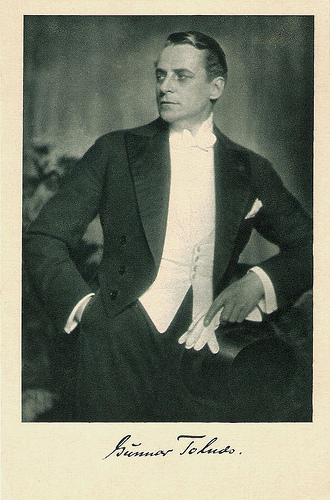
German postcard by Verlag W.J. Mörlins, Berlin / Vertrieb Ross-Verlag, Berlin, no. 9001/3. Photo: Karl Schenker.

Vintage postcard by ABC, no. 375/1.
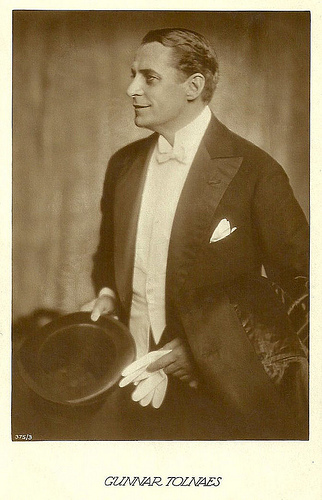
Vintage postcard by ABC, no. 375/3.
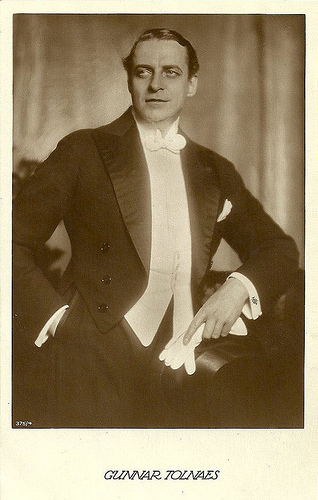
Vintage postcard by ABC, no. 375/4.
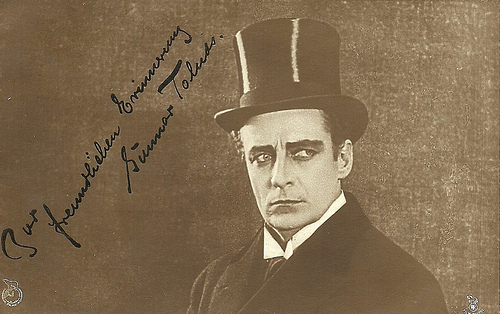
German postcard in the Film Sterne series by Rotophot. Photo: Nordisk. Collection: Didier Hanson.
Super Power
Gunnar Tolnaes (Tolnæs) was born in Christiana (now Oslo), Norway, in 1879. His parents were Ole Gundersen Tolnæs and Helene Andresen (Braathu).
He studied law and later medicine. He made his stage début in 1906, and was an company member of the Nationaltheatret in Oslo between 1908 and 1916.
In 1913, he started his film career for the Swedish company Svenska Biografteatern AB in Stockholm and worked there with legendary director Victor Sjöström . They made the silent dramas Halvblod/Half Breed (Victor Sjöström, 1915) with Karin Molander , Gatans barn/Children of the Streets (Victor Sjöström, 1914) starring Lili Beck , and En av de många/One of the Many (Victor Sjöström, 1915).
He also worked with the other great director of the silent Swedish cinema, Mauritz Stiller. They made Bröderna/Brothers (Mauritz Stiller, 1914) with Carlo Wieth , and När konstnärer älska/When Artists Love (1915, Mauritz Stiller), with Lili Beck .
Then Tolnaes moved to Denmark, where he was offered a contract at the Nordisk studio. He was immediately successful with Doktor X/Doctor X (1915) directed by Robert Dinesen .

German postcard by Photochemie, no. K. 1913. Photo: Nordisk Films. Gunnar Tolnaes in Pjerrot (Hjalmar Davidsen, 1917), with Ulla Nielsen as The Child.

German postcard by Photochemie, Berlin, no. K. 1920. Photo: Nordisk. Publicity still for Pjerrot (Hjalmar Davidsen, 1917).
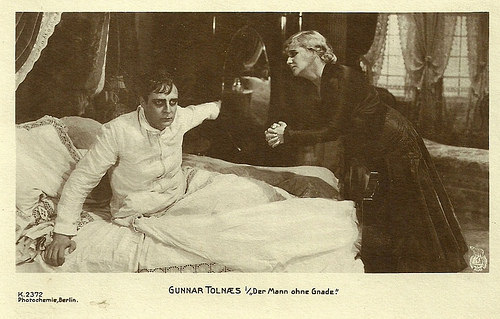
German postcard by Photochemie, no. K.2372. Photo: Nordisk Films. Gunnar Tolnaes in Den Retfærdiges Hustru (A.W. Sandberg, 1917), co-starring Else Frölich .
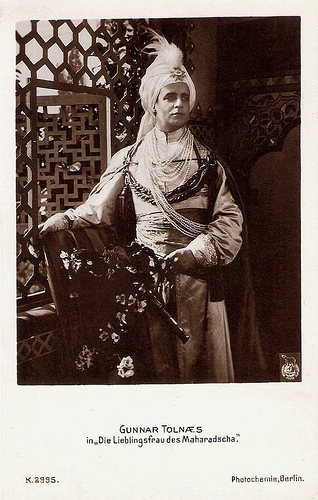
German postcard by Photochemie, Berlin, no. K. 2995. Photo: Nordisk. Publicity still for Maharadjahens Yndlingshustru/The Maharajah's Favourite Wife (1917).

German postcard by Photochemie, Berlin. Photo: Nordisk. Publicity still for Maharadjahens Yndlingshustru/The Maharajah's Favourite Wife (1917) with Lilly Jacobson .
Indian Prince
The studio heads at Nordisk hoped that Gunnar Tolnaes would become as popular as their biggest star, Valdemar Psilander .
Tolnaes had his most famous performance for Nordisk in the Orientalist melodrama Maharadjahens Yndlingshustru I/The Maharajah's Favourite Wife I (Robert Dinesen, 1917). He starred as an Indian prince and Lilly Jacobson was his love interest.
The film was so popular that it had a sequel in 1919, directed by August Blom and again starring Tolnaes and Jacobson. In 1921 the German studio PAGU would produce another sequel Die Lieblingsfrau des Maharadschas - 3. Teil/The Maharajah's Favourite Wife III (Max Mack, 1921) in which Aud Egede Nissen replaced Jacobson.
The Danish film industry was an international superpower in the 1910s and the Nordisk productions were the most successful of them all - especially in Germany. Among Tolnaes' successes were Den retfærdiges hustru/The Righteous Wife (A.W. Sandberg, 1917) with Else Frölich , Den mystiske tjener/The mysterious servant (A.W. Sandberg, 1917) and the science-fiction film Himmelskibet/400 Million Miles from Earth (Holger Madsen, 1918).
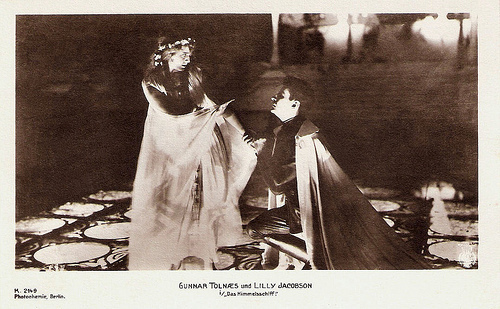
German postcard by Photochemie, Berlin, no. K. 2149. Photo: Nordisk. Publicity still for Himmelskibet/Das Himmelschiff (Holger-Madsen, 1918) with Lilly Jacobson as Marya, the Martian leader's daughter, and Gunnar Tolnaes as Avanti Planetaros.
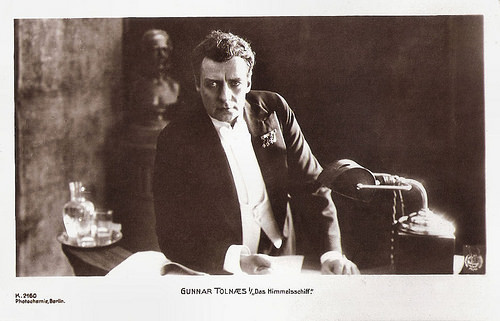
German postcard by Photochemie, Berlin, no. K. 2160. Photo: Nordisk. Publicity still for Himmelskibet/Das Himmelschiff (Holger-Madsen, 1918) with Gunnar Tolnaes as Avanti Planetaros.
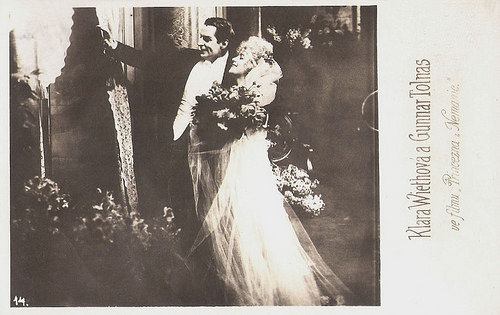
Latvian postcard, no. 14. Photo: Nordisk. Publicity still for Stodderprinsessen/The Rags Princess (A.W. Sandberg, 1920) with Clara Wieth .
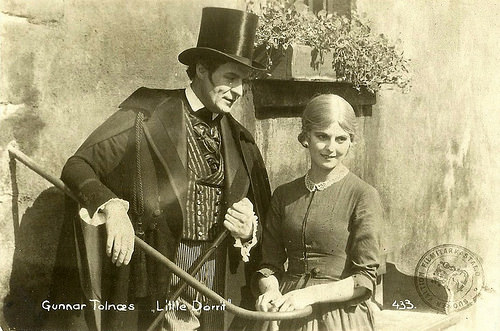
Finnish postcard, no. 433. The postcard carries a stamp of the Finnish film inspection office. Photo: publicity still for the Charles Dickens adaptation Lille Dorritt/Little Dorrit (A.W. Sandberg, 1924), starring Karina Bell as Little Dorrit and Gunnar Tolnaes as Arthur Clennam.
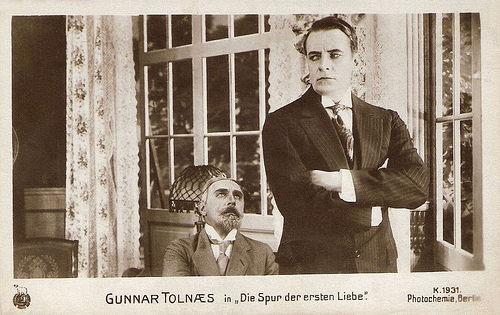
German postcard by Photochemie, Berlin, no. K 1931. Photo: Nordisk. Publicity still for Kærlighedsøen/Love Lake (A.W. Sandberg, 1924).
Less Success
In the 1920s, Gunnar Tolnaes worked often with famous Danish director A.W. Sandberg.
He appeared among others in his Stodderprinsessen/The Rags Princess (A.W. Sandberg, 1920) with Clara Pontoppidan aka Clara Wieth , Kan disse ojne lyve?/Can these eyes lie? (A.W. Sandberg, 1921), Min ven privatdetektiven/My Friend the Private Detective (A.W. Sandberg, 1924), and the Charles Dickens adaptation Lille Dorrit/Little Dorrit (A.W. Sandberg, 1924) with Karina Bell .
The Danish film industry gradually lost its supremacy in Europe, and Gunnar Tolnaes' films also had less success. He alternated acting in Danish films with roles in German films, and continued to do so until the end of the silent era.
His first German film had been Die Lieblingsfrau des Maharadschas - 3. Teil/The Maharajah's Favourite Wife III (Max Mack, 1921). After this success he appeared in productions like Sturmflut des Lebens/Storm Surge of Life (Paul L. Stein, 1921) with Charlotte Ander , Die Flucht in die Ehe/The Flight Into Marriage (Artur Retzbach, 1922), and Wilhelm (later: William) Dieterle 's Geschlecht in Fesseln/Sex in Chains (1928).
His last film was Der Narr seiner Liebe/Fool For Love (1929), directed by actress Olga Tschechova . Gunnar Tolnaes would never make a sound film. He died in 1940 in Oslo, aged 60. He is buried with his family at Vestre gravlund.
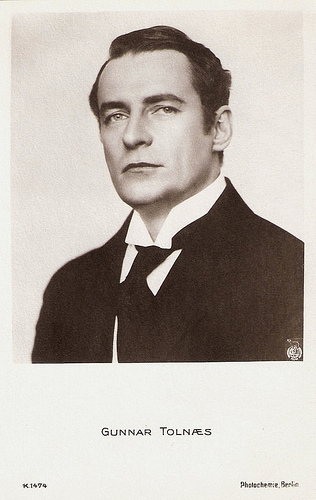
German postcard by Photochemie, Berlin, no. K. 1474. Photo: Nordisk.

German postcard by Photochemie, Berlin, no. K 1567. Photo: Nordisk.

German postcard by Photochemie, Berlin, no. K. 1662. Photo: Nordisk. With Zanny Petersen .
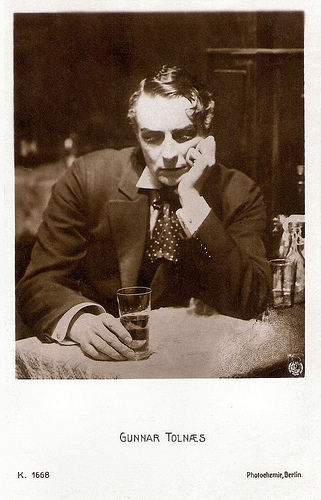
German postcard by Photochemie, Berlin, no. K 1668. Photo: Nordisk.
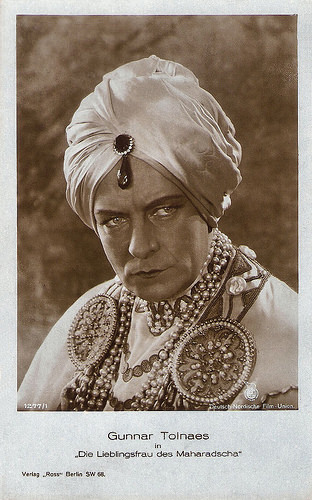
German postcard by Ross Verlag, no. 1277/1, 1927-1928. Photo: Deutsch-Nordische Film Union. Publicity still for Maharadjahens yndlingshustru III/The Maharaja's Favourite Wife (A.W. Sandberg, 1926).
Sources: Thomas Staedeli (Cyranos), Wikipedia (English, Danish and German) and .

German postcard by Verlag W.J. Mörlins, Berlin / Vertrieb Ross-Verlag, Berlin, no. 9001/3. Photo: Karl Schenker.

Vintage postcard by ABC, no. 375/1.

Vintage postcard by ABC, no. 375/3.

Vintage postcard by ABC, no. 375/4.

German postcard in the Film Sterne series by Rotophot. Photo: Nordisk. Collection: Didier Hanson.
Super Power
Gunnar Tolnaes (Tolnæs) was born in Christiana (now Oslo), Norway, in 1879. His parents were Ole Gundersen Tolnæs and Helene Andresen (Braathu).
He studied law and later medicine. He made his stage début in 1906, and was an company member of the Nationaltheatret in Oslo between 1908 and 1916.
In 1913, he started his film career for the Swedish company Svenska Biografteatern AB in Stockholm and worked there with legendary director Victor Sjöström . They made the silent dramas Halvblod/Half Breed (Victor Sjöström, 1915) with Karin Molander , Gatans barn/Children of the Streets (Victor Sjöström, 1914) starring Lili Beck , and En av de många/One of the Many (Victor Sjöström, 1915).
He also worked with the other great director of the silent Swedish cinema, Mauritz Stiller. They made Bröderna/Brothers (Mauritz Stiller, 1914) with Carlo Wieth , and När konstnärer älska/When Artists Love (1915, Mauritz Stiller), with Lili Beck .
Then Tolnaes moved to Denmark, where he was offered a contract at the Nordisk studio. He was immediately successful with Doktor X/Doctor X (1915) directed by Robert Dinesen .

German postcard by Photochemie, no. K. 1913. Photo: Nordisk Films. Gunnar Tolnaes in Pjerrot (Hjalmar Davidsen, 1917), with Ulla Nielsen as The Child.

German postcard by Photochemie, Berlin, no. K. 1920. Photo: Nordisk. Publicity still for Pjerrot (Hjalmar Davidsen, 1917).

German postcard by Photochemie, no. K.2372. Photo: Nordisk Films. Gunnar Tolnaes in Den Retfærdiges Hustru (A.W. Sandberg, 1917), co-starring Else Frölich .

German postcard by Photochemie, Berlin, no. K. 2995. Photo: Nordisk. Publicity still for Maharadjahens Yndlingshustru/The Maharajah's Favourite Wife (1917).

German postcard by Photochemie, Berlin. Photo: Nordisk. Publicity still for Maharadjahens Yndlingshustru/The Maharajah's Favourite Wife (1917) with Lilly Jacobson .
Indian Prince
The studio heads at Nordisk hoped that Gunnar Tolnaes would become as popular as their biggest star, Valdemar Psilander .
Tolnaes had his most famous performance for Nordisk in the Orientalist melodrama Maharadjahens Yndlingshustru I/The Maharajah's Favourite Wife I (Robert Dinesen, 1917). He starred as an Indian prince and Lilly Jacobson was his love interest.
The film was so popular that it had a sequel in 1919, directed by August Blom and again starring Tolnaes and Jacobson. In 1921 the German studio PAGU would produce another sequel Die Lieblingsfrau des Maharadschas - 3. Teil/The Maharajah's Favourite Wife III (Max Mack, 1921) in which Aud Egede Nissen replaced Jacobson.
The Danish film industry was an international superpower in the 1910s and the Nordisk productions were the most successful of them all - especially in Germany. Among Tolnaes' successes were Den retfærdiges hustru/The Righteous Wife (A.W. Sandberg, 1917) with Else Frölich , Den mystiske tjener/The mysterious servant (A.W. Sandberg, 1917) and the science-fiction film Himmelskibet/400 Million Miles from Earth (Holger Madsen, 1918).

German postcard by Photochemie, Berlin, no. K. 2149. Photo: Nordisk. Publicity still for Himmelskibet/Das Himmelschiff (Holger-Madsen, 1918) with Lilly Jacobson as Marya, the Martian leader's daughter, and Gunnar Tolnaes as Avanti Planetaros.

German postcard by Photochemie, Berlin, no. K. 2160. Photo: Nordisk. Publicity still for Himmelskibet/Das Himmelschiff (Holger-Madsen, 1918) with Gunnar Tolnaes as Avanti Planetaros.

Latvian postcard, no. 14. Photo: Nordisk. Publicity still for Stodderprinsessen/The Rags Princess (A.W. Sandberg, 1920) with Clara Wieth .

Finnish postcard, no. 433. The postcard carries a stamp of the Finnish film inspection office. Photo: publicity still for the Charles Dickens adaptation Lille Dorritt/Little Dorrit (A.W. Sandberg, 1924), starring Karina Bell as Little Dorrit and Gunnar Tolnaes as Arthur Clennam.

German postcard by Photochemie, Berlin, no. K 1931. Photo: Nordisk. Publicity still for Kærlighedsøen/Love Lake (A.W. Sandberg, 1924).
Less Success
In the 1920s, Gunnar Tolnaes worked often with famous Danish director A.W. Sandberg.
He appeared among others in his Stodderprinsessen/The Rags Princess (A.W. Sandberg, 1920) with Clara Pontoppidan aka Clara Wieth , Kan disse ojne lyve?/Can these eyes lie? (A.W. Sandberg, 1921), Min ven privatdetektiven/My Friend the Private Detective (A.W. Sandberg, 1924), and the Charles Dickens adaptation Lille Dorrit/Little Dorrit (A.W. Sandberg, 1924) with Karina Bell .
The Danish film industry gradually lost its supremacy in Europe, and Gunnar Tolnaes' films also had less success. He alternated acting in Danish films with roles in German films, and continued to do so until the end of the silent era.
His first German film had been Die Lieblingsfrau des Maharadschas - 3. Teil/The Maharajah's Favourite Wife III (Max Mack, 1921). After this success he appeared in productions like Sturmflut des Lebens/Storm Surge of Life (Paul L. Stein, 1921) with Charlotte Ander , Die Flucht in die Ehe/The Flight Into Marriage (Artur Retzbach, 1922), and Wilhelm (later: William) Dieterle 's Geschlecht in Fesseln/Sex in Chains (1928).
His last film was Der Narr seiner Liebe/Fool For Love (1929), directed by actress Olga Tschechova . Gunnar Tolnaes would never make a sound film. He died in 1940 in Oslo, aged 60. He is buried with his family at Vestre gravlund.

German postcard by Photochemie, Berlin, no. K. 1474. Photo: Nordisk.

German postcard by Photochemie, Berlin, no. K 1567. Photo: Nordisk.

German postcard by Photochemie, Berlin, no. K. 1662. Photo: Nordisk. With Zanny Petersen .

German postcard by Photochemie, Berlin, no. K 1668. Photo: Nordisk.

German postcard by Ross Verlag, no. 1277/1, 1927-1928. Photo: Deutsch-Nordische Film Union. Publicity still for Maharadjahens yndlingshustru III/The Maharaja's Favourite Wife (A.W. Sandberg, 1926).
Sources: Thomas Staedeli (Cyranos), Wikipedia (English, Danish and German) and .
Published on August 20, 2016 22:00
August 19, 2016
Stan Laurel and Oliver Hardy
Thin Englishman Stan Laurel (1890–1965) and heavyset American Oliver Hardy (1892–1957) were a comedy double act during the early classical Hollywood era. They became well known during the late 1920s through the mid-1940s for their slapstick comedy with Laurel playing the clumsy and childlike friend of the pompous Hardy. After the war, they were still very popular in Europe, where they made their final, little known film. Starting today, the exhibition Laurel and Hardy in Europe can be seen in the Geoffrey Donaldson Institute in Noord-Scharwoude, The Netherlands.
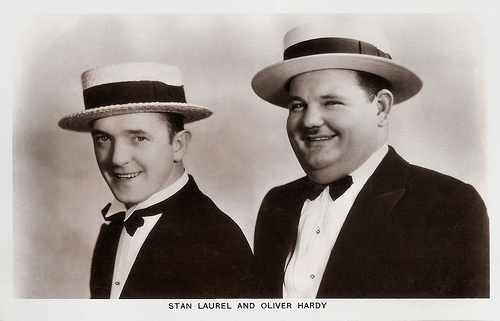
British postcard in the Picturegoer Series, London, no. 491.

Dutch postcard, no. 86. Photo: Metro-Goldwyn-Mayer.
Putting Pants on Philip
Prior to their being teamed up, Stan Laurel and Oliver Hardy both had well established film careers. Stan Laurel had appeared in over 50 films and Oliver Hardy had been in more than 250 productions.
Stan Laurel was born in 1890 as Arthur Stanley Jefferson in Ulverston, England into a theatrical family. His father Arthur Joseph Jefferson was a theatrical entrepreneur and theatre owner in northern England and Scotland who, together with his wife, was a major force in the industry. He made his stage debut in the Britannia Panopticon in Glasgow one month short of his 16th birthday. In 1909, Laurel was employed by Britain's leading comedy impresario Fred Karno as a supporting actor, and as an understudy for Charlie Chaplin .
In 1912, Jefferson left England with the Fred Karno Troupe to tour the United States. He had expected the tour to be merely a pleasant interval before returning to London; however, he emigrated to the U.S. during the trip. In 1917, Stan Jefferson made his film debut with his first wife Mae Dahlberg in Nuts in May.
From then on he began using the name Stan Laurel. In 1931, he changed his name legally. With his early silent films, he experienced only modest success. It was difficult for producers, writers, and directors to write for his character, with American audiences knowing him either as a 'nutty burglar' or as a Charlie Chaplin imitator.
Oliver Hardy was born Norvell Hardy in Harlem, Georgia, in 1892. As a boy, he was a gifted singer, and by age eight, was performing with minstrel shows. By his late teens, Hardy operated a cinema in Milledgeville, Georgia, the Palace Theater, financed in part by his mother. In 1913, he began working as a comic actor with Lubin Motion Pictures in Jacksonville. For his stage name he took his father's first name calling himself Oliver Norvell Hardy while offscreen his nicknames were Ollie and Babe. Hardy was billed as Babe Hardy in his first film, Outwitting Dad(Arthur Hotaling, 1914).
Between 1914 and 1916, Hardy made 177 shorts as Babe with the Vim Comedy Company that were released up to the end of 1917. He showed versatility in playing heroes, villains and even female characters, Hardy was in demand for roles as a supporting actor, comic villain or second banana. For 10 years he memorably assisted star comic and Charlie Chaplin imitator Billy West, Jimmy Aubrey, Larry Semon, and Charley Chase.
The two comedians first worked together as cast members on the film The Lucky Dog (Jesse Robbins, 1921). Though they appear in scenes together, they play independent of each other and not as the comedic team that they would later become. In fact, they did not see each other for another 2 or 3 years. In 1926, both separately signed contracts with the Hal Roach film studio, and then they appeared again in a silent short film together.
Laurel and Hardy officially became a team in the silent short film Putting Pants on Philip (Clyde Bruckman, 1927). Laurel plays Philip, a young Scot newly arrived in the United States, in full kilted splendor, suffering mishaps involving the kilt. His uncle, played by Hardy, is shown trying to put trousers on him. The idea for the film was Stan Laurel's and was based on a story recounted by a friend while Laurel worked in music hall.
Although Putting Pants on Philip was their first 'official film as a team, the iconic Stan and Ollie characters and costumes had yet to become a permanent fixture. Their first appearance as the Stan and Ollie characters was in The Second Hundred Years (Fred Guiol, 1927). The film was supervised by Leo McCarey, who suggested that the performers be teamed permanently. They became a huge hit as a comedy team, and after several years of two-reelers, Roach decided to star them in features. Their first feature-length starring roles were in Pardon Us (James Parrott, 1931).

French postcard by Editions P.I., Paris, offered by Kes Carbones Korès Carboplane, no. 221, 1951. Photo: Metro Goldwyn Mayer (MGM).
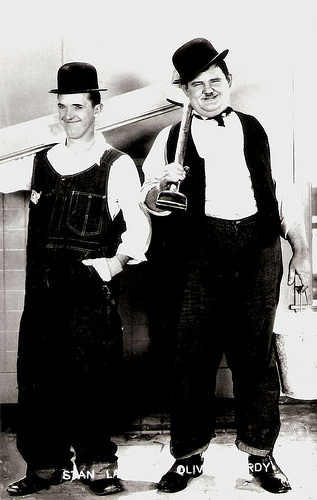
Dutch postcard by Forte.
Well, here's another nice mess you've gotten me into!
Stan Laurel and Oliver Hardy remained with the Roach studio until 1940. Here, they starred in such classics as Sons of the Desert (1933) with Charlie Chase, Babes in Toyland (Gus Meins, Charley Rogers, 1934), Way Out West (James W. Horne, 1937), Block-Heads (John G. Blystone, 1938) and A Chump at Oxford (Alfred J. Goulding).
A popular routine the team performed was a 'tit-for-tat' fight with an adversary. This could be with their wives or with a neighbor. Laurel and Hardy would accidentally damage someone's property, with the injured party retaliating by ruining something belonging to them. After calmly surveying the damage, they would find something else to vandalize, and conflict would escalate until both sides were simultaneously destroying items in front of each other. The catchphrase most used by them is: "Well, here's another nice mess you've gotten me into!"
Wikipedia : "The humor of Laurel and Hardy was highly visual with slapstick used for emphasis. They often had physical arguments with each other (in character), which were quite complex and involved cartoon violence, and their characters preclude them from making any real progress in the simplest endeavors. Much of their comedy involves milking a joke, where a simple idea provides a basis from which to build multiple gags without following a defined narrative."
From 1941 to 1945, Stan Laurel and Oliver Hardy appeared in eight B movie comedies for 20th Century Fox and Metro-Goldwyn-Mayer. Their work became more production-line and less popular during the war years. Their last Hollywood movie together was The Bullfighters (Malcolm St. Clair, 1945). From then on, they concentrated on performing in stage shows and embarked on a music hall tour of England, Ireland and Scotland.
In post-World War II Europe, Laurel and Hardy were enjoying a new popularity with audiences that had been unable to see their films during wartime. As a result of this, the pair received an offer from a French-Italian cinematic consortium to star in a film to be produced in France for $1.5 million, a large budget for the era.
The French/Italian co-production, called Atoll K/Utopia (Léo Joannon, 1951), would be their final film together. The film co-stars French singer/actress Suzy Delair as nightclub singer Chérie Lamour and was directed by Léo Joannon, with uncredited co-direction by blacklisted U.S. director John Berry. The production of the film was riddles with problems and critical reaction was overwhelmingly poor.
As a team Laurel and Hardy had appeared in 107 films, with the pair starring in 32 short silent films, 40 short sound films and 23 full-length feature films. They also made 12 guest or cameo appearances that included the Galaxy of Stars promotional film of 1936. Hardy appeared without Laurel in a few features, such as Zenobia (Gordon Douglas, 1939) with Harry Langdon, The Fighting Kentuckian (George Waggner, 1949) in a semi-comedic role as a frontiersman alongside John Wayne and Riding High (Frank Capra, 1950), in a cameo role.
In 1954 the pair made one American television appearance when they were surprised and interviewed by Ralph Edwards on his live NBC-TV program This Is Your Life. In 1960 Stan Laurel was given a special Oscar "for his creative pioneering in the field of cinema comedy". He died five years later. Oliver Hardy had died in 1957.
Since the 1930s, the works of Laurel and Hardy have been released in numerous theatrical reissues, television revivals, 8-mm and 16-mm home movies, feature-film compilations and home videos. And now there is this little exhibition in Noord-Scharwoude.
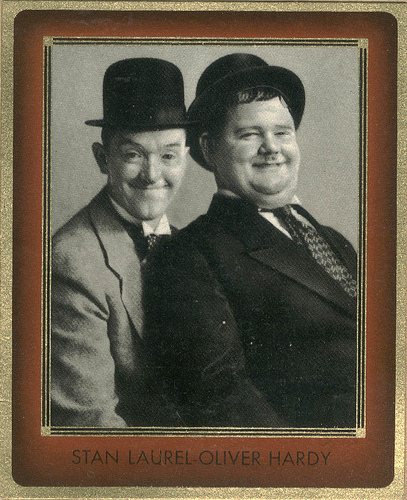
German collectors card in the Bunte Filmbilder series by Greilingen Zigaretten, no. 56. Collection: Manuel Palomino Arjona (Flickr).
American trailer for Atoll K/Utopia (1951). Source: Inter-Pathé Trailer (YouTube).
Source: (IMDb), Wikipedia and .

British postcard in the Picturegoer Series, London, no. 491.

Dutch postcard, no. 86. Photo: Metro-Goldwyn-Mayer.
Putting Pants on Philip
Prior to their being teamed up, Stan Laurel and Oliver Hardy both had well established film careers. Stan Laurel had appeared in over 50 films and Oliver Hardy had been in more than 250 productions.
Stan Laurel was born in 1890 as Arthur Stanley Jefferson in Ulverston, England into a theatrical family. His father Arthur Joseph Jefferson was a theatrical entrepreneur and theatre owner in northern England and Scotland who, together with his wife, was a major force in the industry. He made his stage debut in the Britannia Panopticon in Glasgow one month short of his 16th birthday. In 1909, Laurel was employed by Britain's leading comedy impresario Fred Karno as a supporting actor, and as an understudy for Charlie Chaplin .
In 1912, Jefferson left England with the Fred Karno Troupe to tour the United States. He had expected the tour to be merely a pleasant interval before returning to London; however, he emigrated to the U.S. during the trip. In 1917, Stan Jefferson made his film debut with his first wife Mae Dahlberg in Nuts in May.
From then on he began using the name Stan Laurel. In 1931, he changed his name legally. With his early silent films, he experienced only modest success. It was difficult for producers, writers, and directors to write for his character, with American audiences knowing him either as a 'nutty burglar' or as a Charlie Chaplin imitator.
Oliver Hardy was born Norvell Hardy in Harlem, Georgia, in 1892. As a boy, he was a gifted singer, and by age eight, was performing with minstrel shows. By his late teens, Hardy operated a cinema in Milledgeville, Georgia, the Palace Theater, financed in part by his mother. In 1913, he began working as a comic actor with Lubin Motion Pictures in Jacksonville. For his stage name he took his father's first name calling himself Oliver Norvell Hardy while offscreen his nicknames were Ollie and Babe. Hardy was billed as Babe Hardy in his first film, Outwitting Dad(Arthur Hotaling, 1914).
Between 1914 and 1916, Hardy made 177 shorts as Babe with the Vim Comedy Company that were released up to the end of 1917. He showed versatility in playing heroes, villains and even female characters, Hardy was in demand for roles as a supporting actor, comic villain or second banana. For 10 years he memorably assisted star comic and Charlie Chaplin imitator Billy West, Jimmy Aubrey, Larry Semon, and Charley Chase.
The two comedians first worked together as cast members on the film The Lucky Dog (Jesse Robbins, 1921). Though they appear in scenes together, they play independent of each other and not as the comedic team that they would later become. In fact, they did not see each other for another 2 or 3 years. In 1926, both separately signed contracts with the Hal Roach film studio, and then they appeared again in a silent short film together.
Laurel and Hardy officially became a team in the silent short film Putting Pants on Philip (Clyde Bruckman, 1927). Laurel plays Philip, a young Scot newly arrived in the United States, in full kilted splendor, suffering mishaps involving the kilt. His uncle, played by Hardy, is shown trying to put trousers on him. The idea for the film was Stan Laurel's and was based on a story recounted by a friend while Laurel worked in music hall.
Although Putting Pants on Philip was their first 'official film as a team, the iconic Stan and Ollie characters and costumes had yet to become a permanent fixture. Their first appearance as the Stan and Ollie characters was in The Second Hundred Years (Fred Guiol, 1927). The film was supervised by Leo McCarey, who suggested that the performers be teamed permanently. They became a huge hit as a comedy team, and after several years of two-reelers, Roach decided to star them in features. Their first feature-length starring roles were in Pardon Us (James Parrott, 1931).

French postcard by Editions P.I., Paris, offered by Kes Carbones Korès Carboplane, no. 221, 1951. Photo: Metro Goldwyn Mayer (MGM).

Dutch postcard by Forte.
Well, here's another nice mess you've gotten me into!
Stan Laurel and Oliver Hardy remained with the Roach studio until 1940. Here, they starred in such classics as Sons of the Desert (1933) with Charlie Chase, Babes in Toyland (Gus Meins, Charley Rogers, 1934), Way Out West (James W. Horne, 1937), Block-Heads (John G. Blystone, 1938) and A Chump at Oxford (Alfred J. Goulding).
A popular routine the team performed was a 'tit-for-tat' fight with an adversary. This could be with their wives or with a neighbor. Laurel and Hardy would accidentally damage someone's property, with the injured party retaliating by ruining something belonging to them. After calmly surveying the damage, they would find something else to vandalize, and conflict would escalate until both sides were simultaneously destroying items in front of each other. The catchphrase most used by them is: "Well, here's another nice mess you've gotten me into!"
Wikipedia : "The humor of Laurel and Hardy was highly visual with slapstick used for emphasis. They often had physical arguments with each other (in character), which were quite complex and involved cartoon violence, and their characters preclude them from making any real progress in the simplest endeavors. Much of their comedy involves milking a joke, where a simple idea provides a basis from which to build multiple gags without following a defined narrative."
From 1941 to 1945, Stan Laurel and Oliver Hardy appeared in eight B movie comedies for 20th Century Fox and Metro-Goldwyn-Mayer. Their work became more production-line and less popular during the war years. Their last Hollywood movie together was The Bullfighters (Malcolm St. Clair, 1945). From then on, they concentrated on performing in stage shows and embarked on a music hall tour of England, Ireland and Scotland.
In post-World War II Europe, Laurel and Hardy were enjoying a new popularity with audiences that had been unable to see their films during wartime. As a result of this, the pair received an offer from a French-Italian cinematic consortium to star in a film to be produced in France for $1.5 million, a large budget for the era.
The French/Italian co-production, called Atoll K/Utopia (Léo Joannon, 1951), would be their final film together. The film co-stars French singer/actress Suzy Delair as nightclub singer Chérie Lamour and was directed by Léo Joannon, with uncredited co-direction by blacklisted U.S. director John Berry. The production of the film was riddles with problems and critical reaction was overwhelmingly poor.
As a team Laurel and Hardy had appeared in 107 films, with the pair starring in 32 short silent films, 40 short sound films and 23 full-length feature films. They also made 12 guest or cameo appearances that included the Galaxy of Stars promotional film of 1936. Hardy appeared without Laurel in a few features, such as Zenobia (Gordon Douglas, 1939) with Harry Langdon, The Fighting Kentuckian (George Waggner, 1949) in a semi-comedic role as a frontiersman alongside John Wayne and Riding High (Frank Capra, 1950), in a cameo role.
In 1954 the pair made one American television appearance when they were surprised and interviewed by Ralph Edwards on his live NBC-TV program This Is Your Life. In 1960 Stan Laurel was given a special Oscar "for his creative pioneering in the field of cinema comedy". He died five years later. Oliver Hardy had died in 1957.
Since the 1930s, the works of Laurel and Hardy have been released in numerous theatrical reissues, television revivals, 8-mm and 16-mm home movies, feature-film compilations and home videos. And now there is this little exhibition in Noord-Scharwoude.

German collectors card in the Bunte Filmbilder series by Greilingen Zigaretten, no. 56. Collection: Manuel Palomino Arjona (Flickr).
American trailer for Atoll K/Utopia (1951). Source: Inter-Pathé Trailer (YouTube).
Source: (IMDb), Wikipedia and .
Published on August 19, 2016 22:00
August 18, 2016
EFSP's Dazzling Dozen: From the Small to the Big Screen
There are many examples of film stars who became TV stars. Think Joan Collins in Dynasty (1981–1989) or more recently Gérard Dépardieu in Marseille (2016), the first French original production for Netflix. The other way around, the jump seems to be more difficult. So today at EFSP 12 postcards of dazzling TV stars who transferred successfully to the big screen.

British postcard by D. Constance Ltd, London, no. 106. Photo: Reisfeld / Ufa. Publicity still for the TV series Rawhide (1959–1966).
Before he rose to fame as the Man with No Name in Sergio Leone's classic Spaghetti Westerns Per un pugno di dollari/A Fistful of Dollars (1964), Per qualche dollaro in più/For a Few Dollars More (1965), and Il buono, il brutto, il cattivo/The Good, the Bad and the Ugly (1966), Clint Eastwood (1930) was a TV star as Rowdy Yates in the Western series Rawhide (1959–1966).
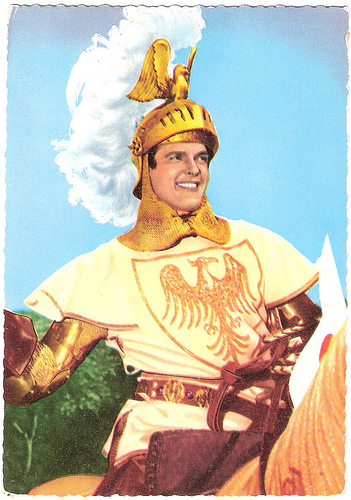
Belgian postcard by S. Best (SB), Antwerpen. Photo: still for Ivanhoe (1958-1959).
Roger Moore (1927) will always be remembered as the guy who replaced Sean Connery in the James Bond series, but he was also our favourite Ivanhoe, Saint and Persuader on TV.
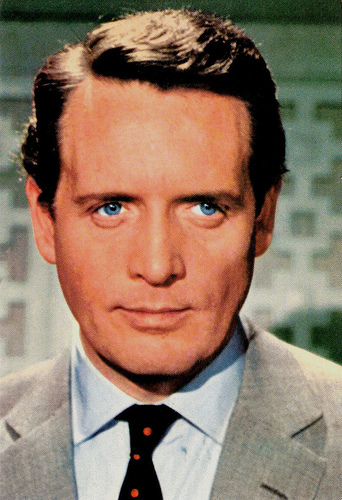
Spanish postcard by Oscar Color, Hospitalet (Barcelona), no. 612.
Though born in America, Irish actor Patrick McGoohan (1928-2009) rose to become the number-one British TV star in the 1950s to 1960s era. In 1959, he was named Best TV Actor of the Year in Britain. Shortly thereafter, he was chosen for the starring role in Secret Agent/Danger Man (1960), which proved to be an immense success for three years and allowed the British to break into the burgeoning American television market for the first time. McGoohan starred in, directed, produced, and wrote many of the episodes of the TV series The Prisoner (1967) about the efforts of a secret agent, who resigned early in his career, to clear his name. His aim was to escape from a fancifully beautiful but psychologically brutal prison for people who know too much. The series was as popular as it was surreal and allegorical and its mysterious final episode caused such an uproar that McGoohan was to desert England for more than 20 years to seek relative anonymity in Hollywood, where he appeared in films like Escape from Alcatraz (1979), Scanners (1981) and Braveheart (1995).
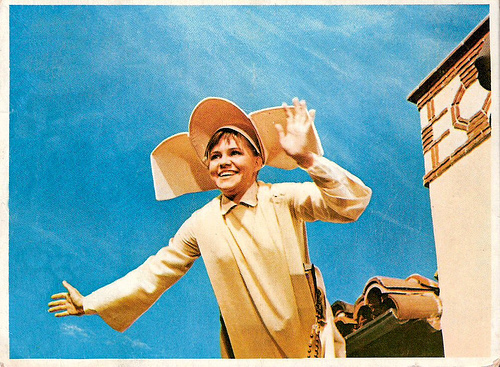
Dutch postcard, no. 24.
Before she won two Oscars, Sally Field starred as the 90-pound novice Sister Bertrille, whose large headgear, enables her to fly in any stiff breeze in The Flying Nun (1967-1970), a sweet American TV series about the misadventures of Bertrille and her convent San Tanco in Puerto Rico.

French postcard by Universal Collections, 2002. Photo: Canal+ Image UK Ltd.
Diana Rigg (1938) played Emma Peel in The Avengers (1961-1969), a delicious, quirky Spy-Fi television series set in cold war Britain. In one hour episodes, The Avengers focused on the adventures of eccentric, suave British agent John Steed (Patrick Macnee) working for the 'Ministry' and his investigative partner Emma Peel, who combined self-assuredness with superior fighting skills, intelligence, and a contemporary fashion sense. Later Diana Rigg played the bride of James Bond in On Her Majesty's Secret Service (1969) and starred in many other films.

Belgian postcard by Best, Antwerpen, no 34. Photo: Humo. Publicity still for the TV series Wij, heren van Zichem/We, gentlemen from Zichem (Maurits Balfoort, 1969).
Belgian actress and theatre director Dora van der Groen (1927-2015) played Melanie in the Belgian TV series Wij, heren van Zichem/We, gentlemen from Zichem (1969), which was very popular at the time in the Lowlands. Later she starred with Kees Brusse in the Dutch film classic Dokter Pulder zaait papavers/Doctor Pulder Sows Poppies (1975) and appeared in more than 120 films and television shows till 2003.
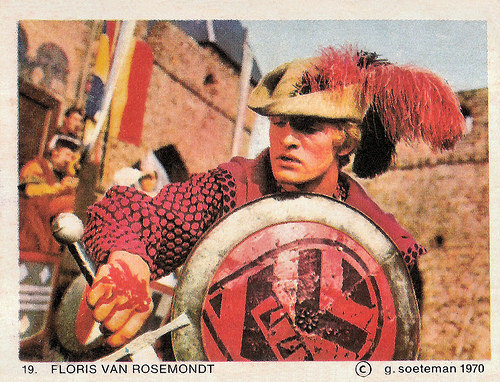
Dutch collectors card, no. 19, 1970. Photo: Gerard Soeteman. Publicity still for the TV series Floris (1969).
Floris (1969) was the start of the successful careers of director Paul Verhoeven, scriptwriter Gerard Soeteman and of course Rutger Hauer . Hauer played the exiled knight Floris van Rosemondt in this Dutch TV series full of intrigues, mysteries and adventures.

French postcard by Editions Atlas, Evreux, no. 6441 904. Photo: publicity still for the TV series La demoiselle d'Avignon/The lady of Avignon (1972).
Beautiful Swiss actress Marthe Keller (1945) appeared in several French, Italian and German films but she became a star when she played a beautiful princess in the TV series La demoiselle d'Avignon/The lady of Avignon (Michel Wyn, 1972). She then seemed to make it big in Hollywood with an award winning role in Marathon Man (1976) and a much-publicised affair with Al Pacino. But the failure of Fedora (1978) halted a major international film career. She continued to act in European productions, and since 1999 she has a new career as an opera director.
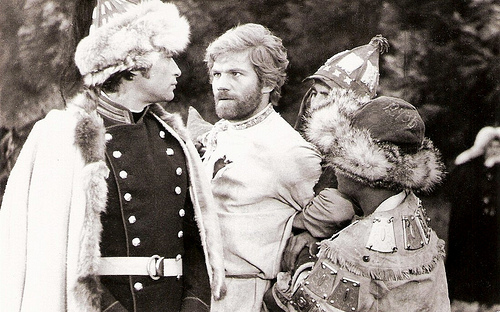
Vintage postcard. Photo: publicity still for the TV series Michael Strogoff: Der Kurier des Zaren/Michel Strogoff (1975).
German actor Raimund Harmstorf (1939-1998) became famous as the protagonist of the German TV mini series Der Seewolf/The Sea-Wolf (1971), based on Jack London's classic novel. Later on, he starred successfully in another German TV series Michael Strogoff: Der Kurier des Zaren/Michel Strogoff (1975), based on Jules Verne's adventure novel. Harmstorf was unforgettable as the handsome hero with a secret mission in an old Russia threatened by Cossacks and frozen rivers, wearing woolly hats and serious faces. Both series were sold to many countries. Harmstorf then became a star of the Eurowestern but his life ended as a tragedy.

German postcard. Photo: Volker Corell.
Handsome actor, director, and producer Til Schweiger (1963) first appeared onscreen in the popular German TV series Lindenstraße (1989-1992). Since then, no other German actor has drawn more people to the cinemas.
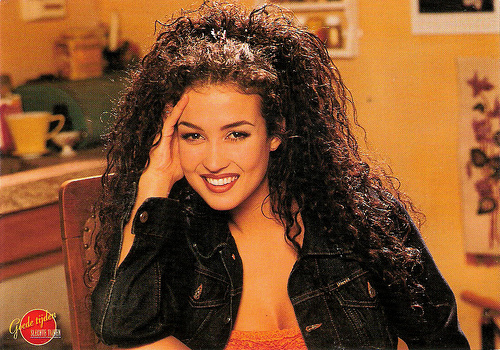
Dutch postcard in the GTST-verzamelkaarten series by RTL4, no. 10. Photo: Govert de Roos. Publicity still for Goede Tijden Slechte Tijden/GTST (1994-1999).
Sexy and exotic Katja Schuurman (1975) was - as Jessica Harmsen in the daily TV series Goede Tijden Slechte Tijden/GTST (1994-1999) - one of the first soap stars of the Netherlands. She showed durability as a TV host and as an actress in many TV series and films.
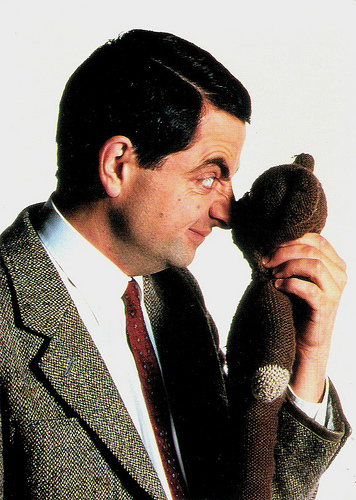
Dutch postcard by Interstat, Amsterdam. Photo: Polygram / CPL.
Funny English actor and screenwriter Rowan Atkinson (1955) is best known for his much-loved historical sitcom Blackadder (1983-1989) and for the series around the clumsy, face-pulling Mr. Bean (1990-1995). The black-haired, bug-eyed, and weak-chinned comedian had also success in the cinema with Bean (1997), the sequel Mr. Bean's Holiday (2007) and with his James Bond parody Johnny English (2003).
This is a post for Postcard Friendship Friday, hosted by Beth at the The Best Hearts are Crunchy. You can visit her by clicking on the button below.


British postcard by D. Constance Ltd, London, no. 106. Photo: Reisfeld / Ufa. Publicity still for the TV series Rawhide (1959–1966).
Before he rose to fame as the Man with No Name in Sergio Leone's classic Spaghetti Westerns Per un pugno di dollari/A Fistful of Dollars (1964), Per qualche dollaro in più/For a Few Dollars More (1965), and Il buono, il brutto, il cattivo/The Good, the Bad and the Ugly (1966), Clint Eastwood (1930) was a TV star as Rowdy Yates in the Western series Rawhide (1959–1966).

Belgian postcard by S. Best (SB), Antwerpen. Photo: still for Ivanhoe (1958-1959).
Roger Moore (1927) will always be remembered as the guy who replaced Sean Connery in the James Bond series, but he was also our favourite Ivanhoe, Saint and Persuader on TV.

Spanish postcard by Oscar Color, Hospitalet (Barcelona), no. 612.
Though born in America, Irish actor Patrick McGoohan (1928-2009) rose to become the number-one British TV star in the 1950s to 1960s era. In 1959, he was named Best TV Actor of the Year in Britain. Shortly thereafter, he was chosen for the starring role in Secret Agent/Danger Man (1960), which proved to be an immense success for three years and allowed the British to break into the burgeoning American television market for the first time. McGoohan starred in, directed, produced, and wrote many of the episodes of the TV series The Prisoner (1967) about the efforts of a secret agent, who resigned early in his career, to clear his name. His aim was to escape from a fancifully beautiful but psychologically brutal prison for people who know too much. The series was as popular as it was surreal and allegorical and its mysterious final episode caused such an uproar that McGoohan was to desert England for more than 20 years to seek relative anonymity in Hollywood, where he appeared in films like Escape from Alcatraz (1979), Scanners (1981) and Braveheart (1995).

Dutch postcard, no. 24.
Before she won two Oscars, Sally Field starred as the 90-pound novice Sister Bertrille, whose large headgear, enables her to fly in any stiff breeze in The Flying Nun (1967-1970), a sweet American TV series about the misadventures of Bertrille and her convent San Tanco in Puerto Rico.

French postcard by Universal Collections, 2002. Photo: Canal+ Image UK Ltd.
Diana Rigg (1938) played Emma Peel in The Avengers (1961-1969), a delicious, quirky Spy-Fi television series set in cold war Britain. In one hour episodes, The Avengers focused on the adventures of eccentric, suave British agent John Steed (Patrick Macnee) working for the 'Ministry' and his investigative partner Emma Peel, who combined self-assuredness with superior fighting skills, intelligence, and a contemporary fashion sense. Later Diana Rigg played the bride of James Bond in On Her Majesty's Secret Service (1969) and starred in many other films.

Belgian postcard by Best, Antwerpen, no 34. Photo: Humo. Publicity still for the TV series Wij, heren van Zichem/We, gentlemen from Zichem (Maurits Balfoort, 1969).
Belgian actress and theatre director Dora van der Groen (1927-2015) played Melanie in the Belgian TV series Wij, heren van Zichem/We, gentlemen from Zichem (1969), which was very popular at the time in the Lowlands. Later she starred with Kees Brusse in the Dutch film classic Dokter Pulder zaait papavers/Doctor Pulder Sows Poppies (1975) and appeared in more than 120 films and television shows till 2003.

Dutch collectors card, no. 19, 1970. Photo: Gerard Soeteman. Publicity still for the TV series Floris (1969).
Floris (1969) was the start of the successful careers of director Paul Verhoeven, scriptwriter Gerard Soeteman and of course Rutger Hauer . Hauer played the exiled knight Floris van Rosemondt in this Dutch TV series full of intrigues, mysteries and adventures.

French postcard by Editions Atlas, Evreux, no. 6441 904. Photo: publicity still for the TV series La demoiselle d'Avignon/The lady of Avignon (1972).
Beautiful Swiss actress Marthe Keller (1945) appeared in several French, Italian and German films but she became a star when she played a beautiful princess in the TV series La demoiselle d'Avignon/The lady of Avignon (Michel Wyn, 1972). She then seemed to make it big in Hollywood with an award winning role in Marathon Man (1976) and a much-publicised affair with Al Pacino. But the failure of Fedora (1978) halted a major international film career. She continued to act in European productions, and since 1999 she has a new career as an opera director.

Vintage postcard. Photo: publicity still for the TV series Michael Strogoff: Der Kurier des Zaren/Michel Strogoff (1975).
German actor Raimund Harmstorf (1939-1998) became famous as the protagonist of the German TV mini series Der Seewolf/The Sea-Wolf (1971), based on Jack London's classic novel. Later on, he starred successfully in another German TV series Michael Strogoff: Der Kurier des Zaren/Michel Strogoff (1975), based on Jules Verne's adventure novel. Harmstorf was unforgettable as the handsome hero with a secret mission in an old Russia threatened by Cossacks and frozen rivers, wearing woolly hats and serious faces. Both series were sold to many countries. Harmstorf then became a star of the Eurowestern but his life ended as a tragedy.

German postcard. Photo: Volker Corell.
Handsome actor, director, and producer Til Schweiger (1963) first appeared onscreen in the popular German TV series Lindenstraße (1989-1992). Since then, no other German actor has drawn more people to the cinemas.

Dutch postcard in the GTST-verzamelkaarten series by RTL4, no. 10. Photo: Govert de Roos. Publicity still for Goede Tijden Slechte Tijden/GTST (1994-1999).
Sexy and exotic Katja Schuurman (1975) was - as Jessica Harmsen in the daily TV series Goede Tijden Slechte Tijden/GTST (1994-1999) - one of the first soap stars of the Netherlands. She showed durability as a TV host and as an actress in many TV series and films.

Dutch postcard by Interstat, Amsterdam. Photo: Polygram / CPL.
Funny English actor and screenwriter Rowan Atkinson (1955) is best known for his much-loved historical sitcom Blackadder (1983-1989) and for the series around the clumsy, face-pulling Mr. Bean (1990-1995). The black-haired, bug-eyed, and weak-chinned comedian had also success in the cinema with Bean (1997), the sequel Mr. Bean's Holiday (2007) and with his James Bond parody Johnny English (2003).
This is a post for Postcard Friendship Friday, hosted by Beth at the The Best Hearts are Crunchy. You can visit her by clicking on the button below.

Published on August 18, 2016 22:00
August 17, 2016
Otto Waalkes
Frisian comedian and actor Otto Waalkes (1948) became famous in the 1970s and 1980s in Germany with his shows, books and films. Many of his sketches have become classics in Germany, and several of his phrases and jokes have become public catchphrases. His perhaps most famous trademark are the Ottifanten (Ottiphants), elephant-like comic characters of his own design.

German promotion card by Rüssl Räckords, Hamburg / Edel. Promotion card for the DVD Otto- Das Orginal.
Ottiphants
Otto Gerhard Waalkes, often simply called Otto, was born in 1948 in Emden, Germany. He was the second son of the master painter Karl Waalkes and his wife Adele, born Lüpkes. Otto got his first guitar when he was 12, and during his high school years, he played in a rock & roll band called the Rustlers, who gave their first public performance in 1964.
In 1970 he attended the Academy of Fine Arts Hamburg, living in a huge apartment-sharing community that counted 14 other residents, among them Udo Lindenberg and Marius Müller-Westernhagen. During his performances with The Rustlers, Waalkes' stage banter and the introductions to his songs proved to be far more popular than the music itself, so before long Waalkes put together a solo program that focused on comedy.
He designed the Ottifanten (Ottiphants), elephant-like comic characters, which would become his most famous trademark. The Ottifanten featured on the cover of his first album, Otto (1973). In the course of his career, he released more than ten comedy albums in Germany, most of them going platinum with more than 500,000 copies sold.
A 1973 TV show called Otto Show was Waalkes' breakthrough. Christian Genzel at AllMusic : “Waalkes' persona is essentially a child in a man's body; his jokes are often intentionally juvenile and silly, often building on numerous puns (in the tradition of his idol, German comedian Heinz Erhardt) and spinning absurd situations into even more absurd territory.”
After a series of popular stand-up live programs on television, Waalkes was ready for the big screen. His first film was the romantic comedy Otto - Der Film (Xaver Schwarzenberger, Otto Waalkes, 1985) bulking of slapstick, verbal jokes, absurdities, satirical side gags and visual ideas. It won the Golden Screen and also a Bambi award and became the most successful German film of all time with 14 million viewers.
Unfortunately, most of Otto's later films were not really up to the standard he set with his first film. These included Otto - Der Neue Film/Otto, the new film (Xaver Schwarzenberger, Otto Waalkes, 1987), Otto - Der Außerfriesische/Otto, The Extra Frisian (Marijan Vajda, Otto Waalkes, 1989) and Otto - Der Liebesfilm/Otto, the love film (Bernd Eilert, Otto Waalkes, 1992). In the 1990s followed several years of little media attention.

German promotion card by Rüssl Musikverlag, Hamburg.
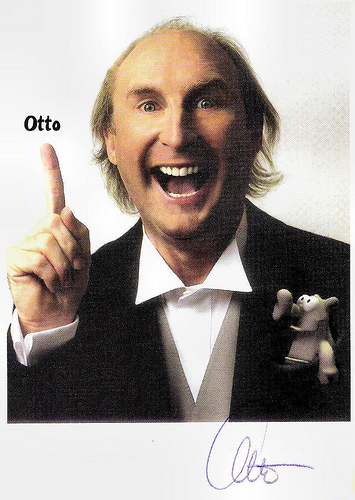
German promotion card by Rüssl Musikverlag, Hamburg / Polydor.
The experiment worked
In the new century Otto Waalkes successfully returned to the cinema with 7 Zwerge/7 Dwarfs (Sven Unterwaldt, 2004), a hilarious parody on Snow White & the Seven Dwarfs with Punkrock-Icon Nina Hagen as the evil queen and her daughter Cosma Shiva Hagen as Snow White. The dwarfs were played by several popular, younger comedians.
The experiment worked and the film drew almost seven million viewers in German cinemas. It re-established Waalkes' popularity with an older and newer generation of fans. The sequel 7 Zwerge - Der Wald ist nicht genug/7 Dwarves: The Forest Is Not Enough (Sven Unterwaldt, 2006) was another box-office hit.
Waalkes also worked as a voice actor, providing the German voices of Mushu in Disney's Mulan (Tony Bancroft, Barry Cook, 1998) and Sid the Sloth in Ice Age (Chris Wedge, Carlos Saldanha, 2002) and its sequels. His recent films include Otto's Eleven (Sven Unterwaldt, 2010) with Mirco Nontschew, and the family film Hilfe, ich hab meine Lehrerin geschrumpft/Help, I Shrunk My Teacher (Sven Unterwaldt, 2015), in which Waalkes had a supporting part.
Otto Waalkes was married twice. From 1987 till 1999, he was married to Manuela Ebelt, with whom he has a son, Benjamin Waalkes. His second wife, from 2000 till 2012, was actress Eva Hassmann, who co-starred with him in Otto – Der Katastrofenfilm. He shares a close friendship with tennis player Steffi Graf, who also appeared as herself in the film Otto – Der Außerfriesische.
Otto Waalkes continues to be a popular and respected figure in Germany's comedy scene.
Trailer Otto - Der Film (1985). Source: RialtoFilm (YouTube).
Trailer Otto's Eleven (2010). Source: Nichts mehr verpassen! (YouTube).
Sources: Christian Genzel (AllMusic), Wikipedia (German and English), and .

German promotion card by Rüssl Räckords, Hamburg / Edel. Promotion card for the DVD Otto- Das Orginal.
Ottiphants
Otto Gerhard Waalkes, often simply called Otto, was born in 1948 in Emden, Germany. He was the second son of the master painter Karl Waalkes and his wife Adele, born Lüpkes. Otto got his first guitar when he was 12, and during his high school years, he played in a rock & roll band called the Rustlers, who gave their first public performance in 1964.
In 1970 he attended the Academy of Fine Arts Hamburg, living in a huge apartment-sharing community that counted 14 other residents, among them Udo Lindenberg and Marius Müller-Westernhagen. During his performances with The Rustlers, Waalkes' stage banter and the introductions to his songs proved to be far more popular than the music itself, so before long Waalkes put together a solo program that focused on comedy.
He designed the Ottifanten (Ottiphants), elephant-like comic characters, which would become his most famous trademark. The Ottifanten featured on the cover of his first album, Otto (1973). In the course of his career, he released more than ten comedy albums in Germany, most of them going platinum with more than 500,000 copies sold.
A 1973 TV show called Otto Show was Waalkes' breakthrough. Christian Genzel at AllMusic : “Waalkes' persona is essentially a child in a man's body; his jokes are often intentionally juvenile and silly, often building on numerous puns (in the tradition of his idol, German comedian Heinz Erhardt) and spinning absurd situations into even more absurd territory.”
After a series of popular stand-up live programs on television, Waalkes was ready for the big screen. His first film was the romantic comedy Otto - Der Film (Xaver Schwarzenberger, Otto Waalkes, 1985) bulking of slapstick, verbal jokes, absurdities, satirical side gags and visual ideas. It won the Golden Screen and also a Bambi award and became the most successful German film of all time with 14 million viewers.
Unfortunately, most of Otto's later films were not really up to the standard he set with his first film. These included Otto - Der Neue Film/Otto, the new film (Xaver Schwarzenberger, Otto Waalkes, 1987), Otto - Der Außerfriesische/Otto, The Extra Frisian (Marijan Vajda, Otto Waalkes, 1989) and Otto - Der Liebesfilm/Otto, the love film (Bernd Eilert, Otto Waalkes, 1992). In the 1990s followed several years of little media attention.

German promotion card by Rüssl Musikverlag, Hamburg.

German promotion card by Rüssl Musikverlag, Hamburg / Polydor.
The experiment worked
In the new century Otto Waalkes successfully returned to the cinema with 7 Zwerge/7 Dwarfs (Sven Unterwaldt, 2004), a hilarious parody on Snow White & the Seven Dwarfs with Punkrock-Icon Nina Hagen as the evil queen and her daughter Cosma Shiva Hagen as Snow White. The dwarfs were played by several popular, younger comedians.
The experiment worked and the film drew almost seven million viewers in German cinemas. It re-established Waalkes' popularity with an older and newer generation of fans. The sequel 7 Zwerge - Der Wald ist nicht genug/7 Dwarves: The Forest Is Not Enough (Sven Unterwaldt, 2006) was another box-office hit.
Waalkes also worked as a voice actor, providing the German voices of Mushu in Disney's Mulan (Tony Bancroft, Barry Cook, 1998) and Sid the Sloth in Ice Age (Chris Wedge, Carlos Saldanha, 2002) and its sequels. His recent films include Otto's Eleven (Sven Unterwaldt, 2010) with Mirco Nontschew, and the family film Hilfe, ich hab meine Lehrerin geschrumpft/Help, I Shrunk My Teacher (Sven Unterwaldt, 2015), in which Waalkes had a supporting part.
Otto Waalkes was married twice. From 1987 till 1999, he was married to Manuela Ebelt, with whom he has a son, Benjamin Waalkes. His second wife, from 2000 till 2012, was actress Eva Hassmann, who co-starred with him in Otto – Der Katastrofenfilm. He shares a close friendship with tennis player Steffi Graf, who also appeared as herself in the film Otto – Der Außerfriesische.
Otto Waalkes continues to be a popular and respected figure in Germany's comedy scene.
Trailer Otto - Der Film (1985). Source: RialtoFilm (YouTube).
Trailer Otto's Eleven (2010). Source: Nichts mehr verpassen! (YouTube).
Sources: Christian Genzel (AllMusic), Wikipedia (German and English), and .
Published on August 17, 2016 22:00
August 16, 2016
Mères françaises (1917)
Today's film special is about the French war propaganda film Mères françaises/French Mothers (René Hervil, Louis Mercanton, 1917) with a series of postcards from Italy. Star of the film was the legendary French actress Sarah Bernhardt, who was 72 at the time, but had not lost her immense star power yet.

Italian postcard. Sarah Bernhardt as Mme D'Urbex in Mères françaises (René Hervil, Louis Mercanton, 1917). Caption: From every corner of France men departed to do their own duty.
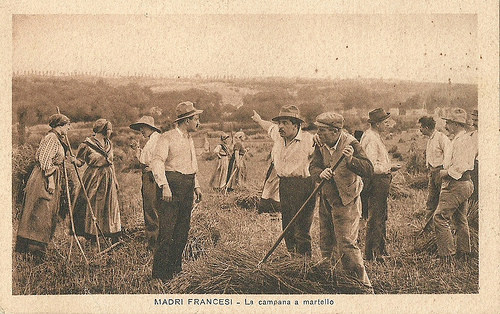
Italian postcard by IPA CT, no. 5747. Photo: publicity still for Mères françaises (René Hervil, Louis Mercanton, 1917). Caption: The bells are hammering.

Italian postcard. Sarah Bernhardt as Mme D'Urbex in Mères françaises (René Hervil, Louis Mercanton, 1917). Caption: Mme D'Urbex is head nurse in a hospital in Reims.
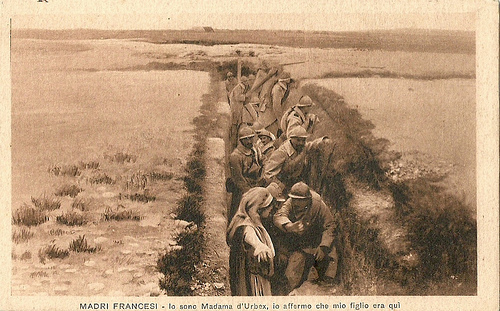
Italian postcard. Sarah Bernhardt as Mme D'Urbex in Mères françaises (René Hervil, Louis Mercanton, 1917). Caption: I am Mme D'Urbex, I confirm my son was here.
The Summer of 1914
Mères françaises/French Mothers (René Hervil, Louis Mercanton, 1917) is a melodrama situated in the summer of 1914, just before the outburst of the 'great war', World War I. French mother Madame Jeanne d'Urbex ( Sarah Bernhardt ) lives with her husband, a retired army officer (George Deneubourg), and son Robert ( Jean Angelo ) at their château in the village of Mercurey in eastern France.
Jeanne is the godmother of Marie Lebroux ( Louise Lagrange ), the daughter of a couple who manage a farm on their estate with their son Victor and an adopted orphan, Noret (Jean Signoret).
Father Lebroux shares the pacifist views of the village schoolmaster, Guinot ( Gabriel Signoret ), and is equally certain that another war is impossible. But when Austro-Hungary declares war on Serbia, it isn't long before the whole of Europe is drawn into a long and bloody conflict.
With their sons, husbands and brothers away fighting for the glory of France, the womenfolk must do their duty back home - gathering in the harvest and tending to the war wounded. Madame d'Urbex is employed as a matron at Reims hospital when she learns that her son has been gravely wounded.
Determined to see him, she risks her own life by venturing close to the enemy lines, but Robert dies before she can reach him. Not long afterwards, she learns that her husband has also been killed in action.
When Guinot returns to his home village, he is blind and, out of a sense of duty, Marie feels bound to marry him. Realising that it is Noret she really loves, Guinot gives her up and urges her to marry Noret instead, insisting that the engagement takes place before Noret returns to the front. Guinot himself will return a - blinded - schoolmaster, beloved by the children and by Mme D'Urbex.
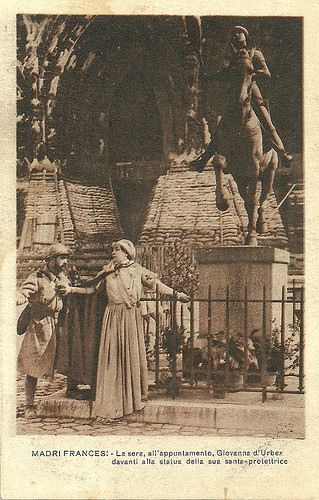
Italian postcard by IPA CT, no. 5742. Sarah Bernhardt in Mères françaises (René Hervil, Louis Mercanton, 1917). Caption: At night, at the appointment, Jeanne d'Urbex stood in front of the statue of her holy patroness.
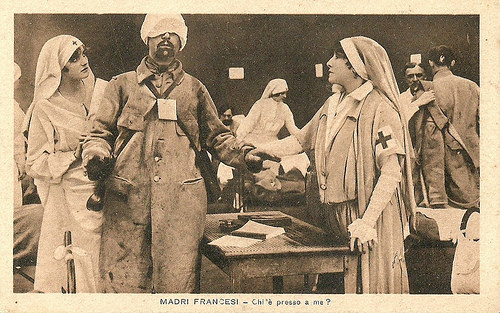
Italian postcard. Sarah Bernhardt as Mme D'Urbex and Gabriel Signoret as Guinot in Mères françaises (René Hervil, Louis Mercanton, 1917). Caption: Who is near me?

Italian postcard. Sarah Bernhardt as Mme D'Urbex, Gabriel Signoret as Guinot and Louise Lagrange as Marie in Mères françaises (René Hervil, Louis Mercanton, 1917). Caption: Sorrowful bethrothal.
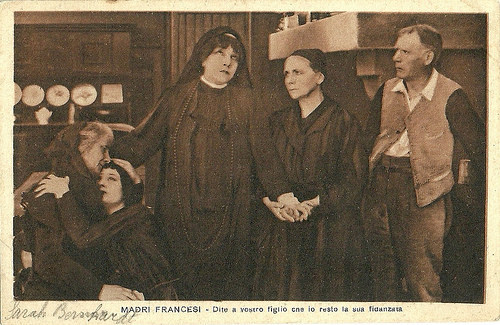
Italian postcard. Sarah Bernhardt as Mme D'Urbex and Louise Lagrange as Marie in Mères françaises (René Hervil, Louis Mercanton, 1917). Caption: Tell your son I will remain his fiancée.
The most famous actress in the history of the world
Mères françaises/French Mothers (René Hervil, Louis Mercanton, 1917) was financed by the French War Ministry and intended primarily for the US market to show what World War I meant for Europe. There are many views of actual trenches, munition depots and infantry revetments. When Sarah Bernhardt plays her climactic scene standing before the statue of Joan of Arc before the Cathedral of Rheims, we can see the actual damage to the cathedral that was caused by German artillery fire.
James Travers at Le Film Guide : "as a propaganda film it is both surprisingly honest and remarkably effective. Instead of justifying the war, or even glorifying those who are actively caught up in its brutal carnage, it confines itself to the duty of the female sex, urging stoicism and resilience through a period of almost unimaginable personal anguish."
It was a vehicle for 'the most famous actress in the history of the world', French vedette Sarah Bernhardt (1844-1923). 'The Divine Sarah' had made her fame on the stages of Europe in the 1870s, and since then, she was also highly in demand in both Americas. Bernhardt became one of the first film stars and even at the age of 72, she starred in Mères Françaises.
A few years earlier, Sarah Bernhardt 's right leg had to be amputated above the knee, after gangrene had set in. It was the result of an old injury. Wearing a long frock to conceal her amputation, she played the entire film by turns either sitting down or carefully standing near something to lean on. We never see her walking. Despite this handicap, Bernhardt put her own safety on risk during the shooting of the exterior scenes near Reims, within twenty kilometres of the enemy lines near the Marne.
Her male co-star was Gabriel Signoret (1878-1937) as the blind schoolmaster Guinot. Signoret played in some 85 films, mostly silent ones. In Mères Françaises his brother Jean Signoret also plays an important part as his rival in love, Noret.
The other co-star was Louise Lagrange (1898-1979), a French screen actress who had a fruitful career in French silent and sound cinema from the Pathé short Cendrillon (1907) onwards. In the early 1920s Lagrange played in the US opposite Rudolph Valentino, while in turn Ricardo Cortez and Ivan Petrovich where her partners in later 1920s French films. In 1933 she became the wife of film director Maurice Tourneur and quitted film acting, apart from just a few, small parts in postwar films.
Despite her excellent co-stars, reviewers think it was Sarah Bernhardt who carried the film. F Gwynplaine MacIntyre at IMDb : "the remnants of her faded beauty are still there, and this film gives some glimpses of the talent that had dazzled theatregoers thirty years earlier." James Travers: "her vitality is still very much in evidence, and her charismatic presence redeems what would otherwise have been a dull and pedestrian wartime melodrama."

Italian postcard. Gabriel Signoret as the blind schoolmaster Guinot, Jean Signoret as Noret and Louise Lagrange as Marie in Mères françaises (René Hervil, Louis Mercanton, 1917). Caption: My dear friends, I cannot accept your sacrifice.

Italian postcard. Sarah Bernhardt as Mme D'Urbex and Gabriel Signoret as Guinot in Mères françaises (René Hervil, Louis Mercanton, 1917). Caption: The schoolmaster returns to his class, which henceforth will be his reason to live.

Italian postcard. Sarah Bernhardt as Mme D'Urbex and Gabriel Signoret as Guinot in Mères françaises (René Hervil, Louis Mercanton, 1917). Caption: The schoolmaster.
Scene from Mères françaises (1917). Source: Cinéma et Histoire (YouTube).
Source: James Travers (Le Film Guide), F Gwynplaine MacIntyre (IMDb) and .

Italian postcard. Sarah Bernhardt as Mme D'Urbex in Mères françaises (René Hervil, Louis Mercanton, 1917). Caption: From every corner of France men departed to do their own duty.

Italian postcard by IPA CT, no. 5747. Photo: publicity still for Mères françaises (René Hervil, Louis Mercanton, 1917). Caption: The bells are hammering.

Italian postcard. Sarah Bernhardt as Mme D'Urbex in Mères françaises (René Hervil, Louis Mercanton, 1917). Caption: Mme D'Urbex is head nurse in a hospital in Reims.

Italian postcard. Sarah Bernhardt as Mme D'Urbex in Mères françaises (René Hervil, Louis Mercanton, 1917). Caption: I am Mme D'Urbex, I confirm my son was here.
The Summer of 1914
Mères françaises/French Mothers (René Hervil, Louis Mercanton, 1917) is a melodrama situated in the summer of 1914, just before the outburst of the 'great war', World War I. French mother Madame Jeanne d'Urbex ( Sarah Bernhardt ) lives with her husband, a retired army officer (George Deneubourg), and son Robert ( Jean Angelo ) at their château in the village of Mercurey in eastern France.
Jeanne is the godmother of Marie Lebroux ( Louise Lagrange ), the daughter of a couple who manage a farm on their estate with their son Victor and an adopted orphan, Noret (Jean Signoret).
Father Lebroux shares the pacifist views of the village schoolmaster, Guinot ( Gabriel Signoret ), and is equally certain that another war is impossible. But when Austro-Hungary declares war on Serbia, it isn't long before the whole of Europe is drawn into a long and bloody conflict.
With their sons, husbands and brothers away fighting for the glory of France, the womenfolk must do their duty back home - gathering in the harvest and tending to the war wounded. Madame d'Urbex is employed as a matron at Reims hospital when she learns that her son has been gravely wounded.
Determined to see him, she risks her own life by venturing close to the enemy lines, but Robert dies before she can reach him. Not long afterwards, she learns that her husband has also been killed in action.
When Guinot returns to his home village, he is blind and, out of a sense of duty, Marie feels bound to marry him. Realising that it is Noret she really loves, Guinot gives her up and urges her to marry Noret instead, insisting that the engagement takes place before Noret returns to the front. Guinot himself will return a - blinded - schoolmaster, beloved by the children and by Mme D'Urbex.

Italian postcard by IPA CT, no. 5742. Sarah Bernhardt in Mères françaises (René Hervil, Louis Mercanton, 1917). Caption: At night, at the appointment, Jeanne d'Urbex stood in front of the statue of her holy patroness.

Italian postcard. Sarah Bernhardt as Mme D'Urbex and Gabriel Signoret as Guinot in Mères françaises (René Hervil, Louis Mercanton, 1917). Caption: Who is near me?

Italian postcard. Sarah Bernhardt as Mme D'Urbex, Gabriel Signoret as Guinot and Louise Lagrange as Marie in Mères françaises (René Hervil, Louis Mercanton, 1917). Caption: Sorrowful bethrothal.

Italian postcard. Sarah Bernhardt as Mme D'Urbex and Louise Lagrange as Marie in Mères françaises (René Hervil, Louis Mercanton, 1917). Caption: Tell your son I will remain his fiancée.
The most famous actress in the history of the world
Mères françaises/French Mothers (René Hervil, Louis Mercanton, 1917) was financed by the French War Ministry and intended primarily for the US market to show what World War I meant for Europe. There are many views of actual trenches, munition depots and infantry revetments. When Sarah Bernhardt plays her climactic scene standing before the statue of Joan of Arc before the Cathedral of Rheims, we can see the actual damage to the cathedral that was caused by German artillery fire.
James Travers at Le Film Guide : "as a propaganda film it is both surprisingly honest and remarkably effective. Instead of justifying the war, or even glorifying those who are actively caught up in its brutal carnage, it confines itself to the duty of the female sex, urging stoicism and resilience through a period of almost unimaginable personal anguish."
It was a vehicle for 'the most famous actress in the history of the world', French vedette Sarah Bernhardt (1844-1923). 'The Divine Sarah' had made her fame on the stages of Europe in the 1870s, and since then, she was also highly in demand in both Americas. Bernhardt became one of the first film stars and even at the age of 72, she starred in Mères Françaises.
A few years earlier, Sarah Bernhardt 's right leg had to be amputated above the knee, after gangrene had set in. It was the result of an old injury. Wearing a long frock to conceal her amputation, she played the entire film by turns either sitting down or carefully standing near something to lean on. We never see her walking. Despite this handicap, Bernhardt put her own safety on risk during the shooting of the exterior scenes near Reims, within twenty kilometres of the enemy lines near the Marne.
Her male co-star was Gabriel Signoret (1878-1937) as the blind schoolmaster Guinot. Signoret played in some 85 films, mostly silent ones. In Mères Françaises his brother Jean Signoret also plays an important part as his rival in love, Noret.
The other co-star was Louise Lagrange (1898-1979), a French screen actress who had a fruitful career in French silent and sound cinema from the Pathé short Cendrillon (1907) onwards. In the early 1920s Lagrange played in the US opposite Rudolph Valentino, while in turn Ricardo Cortez and Ivan Petrovich where her partners in later 1920s French films. In 1933 she became the wife of film director Maurice Tourneur and quitted film acting, apart from just a few, small parts in postwar films.
Despite her excellent co-stars, reviewers think it was Sarah Bernhardt who carried the film. F Gwynplaine MacIntyre at IMDb : "the remnants of her faded beauty are still there, and this film gives some glimpses of the talent that had dazzled theatregoers thirty years earlier." James Travers: "her vitality is still very much in evidence, and her charismatic presence redeems what would otherwise have been a dull and pedestrian wartime melodrama."

Italian postcard. Gabriel Signoret as the blind schoolmaster Guinot, Jean Signoret as Noret and Louise Lagrange as Marie in Mères françaises (René Hervil, Louis Mercanton, 1917). Caption: My dear friends, I cannot accept your sacrifice.

Italian postcard. Sarah Bernhardt as Mme D'Urbex and Gabriel Signoret as Guinot in Mères françaises (René Hervil, Louis Mercanton, 1917). Caption: The schoolmaster returns to his class, which henceforth will be his reason to live.

Italian postcard. Sarah Bernhardt as Mme D'Urbex and Gabriel Signoret as Guinot in Mères françaises (René Hervil, Louis Mercanton, 1917). Caption: The schoolmaster.
Scene from Mères françaises (1917). Source: Cinéma et Histoire (YouTube).
Source: James Travers (Le Film Guide), F Gwynplaine MacIntyre (IMDb) and .
Published on August 16, 2016 22:00
August 15, 2016
Gustav Diessl
Austrian film and stage actor Gustav Diessl (1899-1948) was the hero of the first Mountain film, Die weiße Hölle vom Piz Palü (1929). This film and others by prolific director G.W. Pabst made him at the time an unusual sex symbol: the mature, quiet, somewhat difficult man who attracts women almost against his will. Under the Nazi regime he was often cast as an exotic villain or a mysterious foreigner.
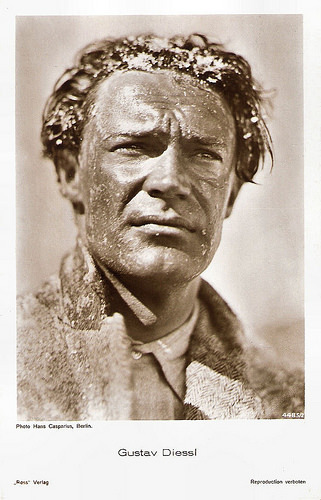
German postcard by Ross Verlag, no. 4485/2, 1929-1930. Photo: Hans Casparius, Berlin. Publicity still for Die weiße Hölle vom Piz Palü/The White Hell of Pitz Palu (Arnold Fanck, G.W. Pabst, 1929).
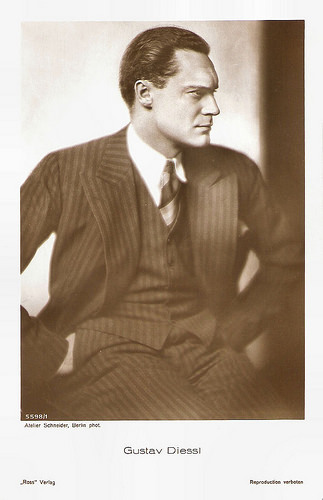
German postcard by Ross Verlag, no. 5598/1, 1930-1931. Photo: Atelier Schneider, Berlin.
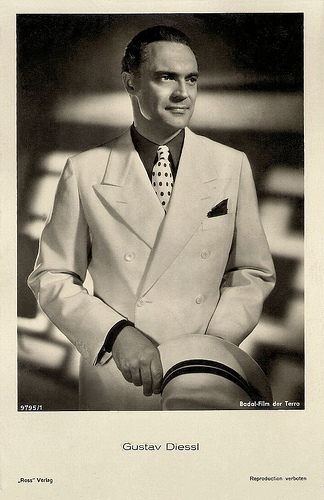
German postcard by Ross Verlag, no. 9795/1, 1935-1936. Photo: Bodal Film der Terra.

German postcard by Ross Verlag, no. A 3091/1, 1941-1944. Photo: Binz, Berlin.
Jack the Ripper
Gustav Diessl was born Gustav Karl Balthasar in Vienna, Austria-Hungary (now Austria). He was the son of a classical scholar and studied art, painting and sculpture at the Kunstgewerbeschule (art school) in Vienna. In 1916, he worked as an extra on different stages in Vienna but he was soon recruited into the army for World War I. During his military service, he was held prisoner for a year.
After the war, Diessl started training as a stage designer but he left to pursue a professional acting career. He played for a touring company and in 1921 had his first fixed engagement at the Neue Wiener Bühne (New Viennese Stage). That same year he appeared in his film debut In Banne der Kralle/In the Spell of the Claw (Carl Froelich, 1921).
The next years he made several films, including the silent films Vineta (Werner Funck, 1923) with Evi Eva , the Austrian-Polish co-production Ssanin/Sanin (Friedrich Feher, Boris Nevolin, 1924) starring Magda Sonja , and Die Rache der Pharaonen/The revenge of the Pharaohs (Hans Theyer, 1924) with Suzy Vernon .
He moved to Berlin where he worked with the prolific director Georg Wilhelm Pabst on Abgründe/Crisis (G. W. Pabst, 1928) opposite Brigitte Helm , and a year later he played Jack the Ripper in Die Büchse der Pandora/Pandora's Box (G. W. Pabst, 1929) with Louise Brooks.
That same year he had his breakthrough with Die weiße Hölle vom Piz Palü/The White Hell of Pitz Palu (Arnold Fanck, G.W. Pabst, 1929) opposite Leni Riefenstahl . It was the first Mountain film, a genre that became very popular in Germany.
Diessl was now a huge star with an unusual kind of sex-appeal. He was the prototype of the mature, quiet, somewhat difficult man who attracts women almost against his will. Very popular was Die Drei um Edith/Three around Edith (Erich Waschneck, 1929) in which he starred opposite Camilla Horn and Jack Trevor .
His first German sound film was the anti-war drama Westfront 1918 (G.W. Pabst, 1930) with Fritz Kampers. In the meantime, Die weiße Hölle vom Piz Palü had made Diessl also famous in the US and he had received an invitation by MGM to come to work in Hollywood.

German postcard by Ross Verlag, no. 5450/1, 1930-1931. Photo: Atelier Schrecker, Berlin.
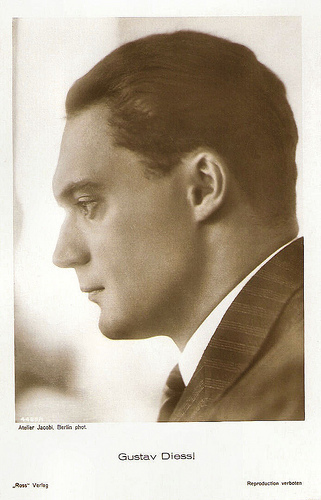
German postcard by Ross Verlag, no. 4485/1, 1929-1930. Photo: Atelier Jacobi, Berlin.
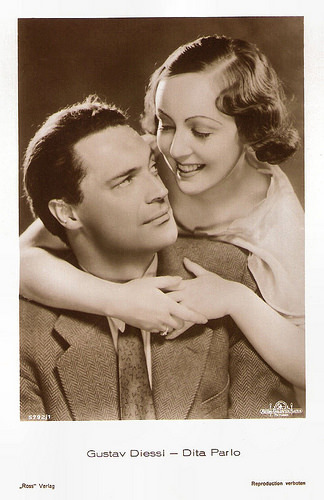
German postcard by Ross Verlag, no. 5792/1, 1930-1931. Photo: Metro-Goldwyn-Mayer. Publicity still for Menschen hinter Gittern (Pál Fejös, 1930) with Dita Parlo . This was the German language version of The Big House (1930). Pál Fejös or Paul Fejos was a Hungarian-born, multi-lingual director, who worked at MGM at the time. He was assigned to direct both German- and French-language 'parallel versions' of The Big House, using different actors but the same costumes and sets at MGM.
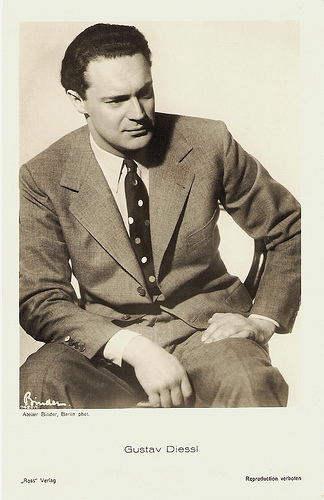
German postcard by Ross Verlag, no. 7420/1, 1932-1933. Photo: Atelier Binder, Berlin.
Demonic Chinese Villain
After making only one American film, Menschen hinter Gittern/Men Behind Bars (1931, Pál Fejös) – the German language version of The Big House (1930, George W. Hill), with Heinrich George in Wallace Beery's role, Gustav Diessl returned to Germany. He immediately started working again.
He appeared in such early sound films as Hans in allen Gassen/Hans in all alleys (Carl Froelich, 1930) with Hans Albers , the French Paramount production Les nuits de Port Said/The Nights of Port Said (Leo Mittler, 1932), and the fantasy film Die Herrin von Atlantis/Mistress of Atlantis (G.W. Pabst, 1932), in which he was the only colonial soldier who could resist the temptations of the seductive mistress of the title, played by Brigitte Helm .
The adventure film S.O.S. Eisberg/SOS Iceberg (Arnold Fanck, 1933), starring Diessl and Riefenstahl again, and the mountain film Weiße Majestät/White Majesty (August Kern, Anton Kutter, 1933) with Hertha Thiele , tried to continue the success of Die weiße Hölle vom Piz Palü/The White Hell of Piz Palu.
During the 1930s, Diessl remained in demand as a sinister villain or difficult to cast foreigner. Already in 1931 he had portrayed a demonic Chinese villain in the exotic drama Das gelbe Haus des King-Fu/The yellow house of King-Fu (Karl Grune, 1931), and he had played a gangster in the highly successful Das Testament des Dr. Mabuse/The Testament of Dr. Mabuse (Fritz Lang, 1933) featuring Rudolf Klein-Rogge .
In the Nazi era, he was shown more frequently as a foreigner. First he appeared in the German-Italian co-production Die Liebe des Maharadscha/The love of the Maharajah (Arthur Maria Rabenalt, 1936) as an in Italy exiled Maharajah, who falls for a piano player (Italian diva Isa Miranda ) because she resembles his deceased wife.
That same year Diessl joined the melodrama Der Weg nach Shanghai/Moscow Shanghai (Paul Wegener, 1936) as a Russian captain, who in the revolutionary turmoil falls in love with a beautiful singer ( Pola Negri ). He again played a Russian in the revolution melodrama Starke Herzen/Strong Hearts (Herbert Maisch, 1937).
Then he appeared as an adventurer who falls in love with the wife of a Maharajah ( La Jana ) in the exotic two parter, Der Tiger von Eschnapur/The Tiger of Eschnapur (Richard Eichberg, 1938) and Das indische Grabmal/The Indian Tomb (Richard Eichberg, 1938). In 1940, he played a rich Brazilian, again opposite La Jana , in the crime film Stern von Rio/Star of Rio (Karl Anton, 1940).
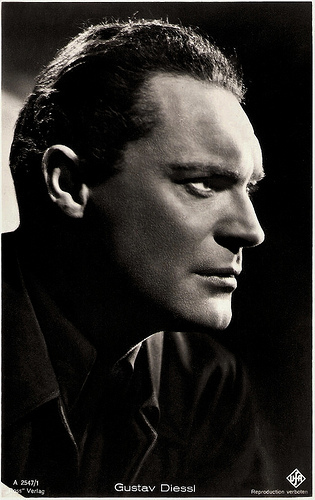
German postcard by Ross Verlag, no. A 2547/1, 1939-1940. Photo: Ufa.
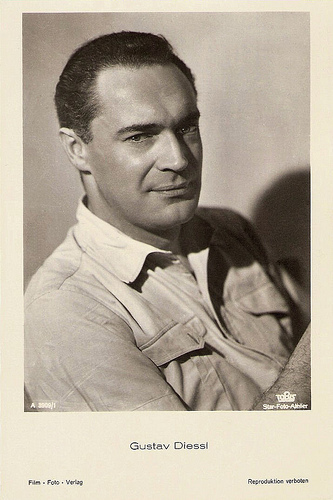
German postcard by Film-Foto-Verlag, no. A 3909/1, 1941-1944. Photo: Star-Foto Atelier / Tobis.
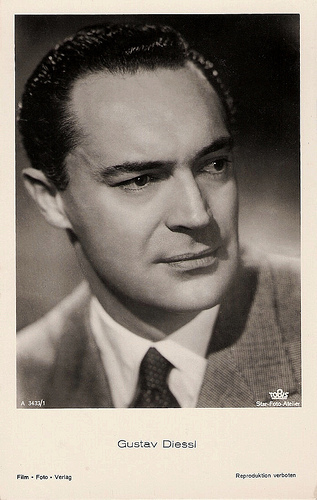
German postcard by Film-Foto-Verlag, no. A 3433/1, 1941-1944. Photo: Star-Foto Atelier / Tobis.
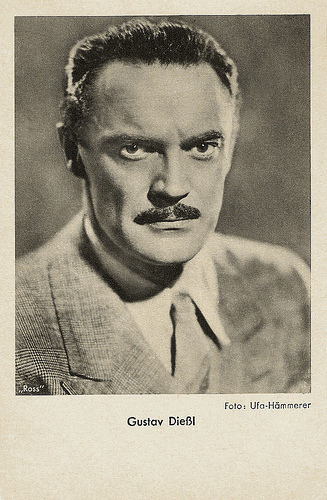
German postcard by Das Programm von Heute, Berlin / Ross Verlag. Photo: Ufa / Hämmerer.
Two Strokes
After his first short-lived marriage with Irmgard Amalie Wettach had ended, Gustav Diessl had lived with actress Camilla Horn for a couple of years. In 1937, during the filming of Starke Herzen/Strong Hearts he met the famous opera singer and actress Maria Cebotari. They fell in love and because of him Cebatori got divorced. They married in 1938 and stayed together for the rest of his life.
During the 1940s, Diessl knew to remain popular, and he played in such films as Komödianten/The Comedians (Georg Wilhelm Pabst, 1941), and the anti-Slovenian propaganda film Menschen im Sturm/People in the Storm (Fritz Peter Buch, 1941) with Olga Tschechova .
Between 1940 and 1944, he worked almost exclusively in Italy. He appeared in such films as Senza cielo/Without Sky (Alfredo Guarini, 1940) with Isa Miranda , La donna del peccato/The woman of the sin (Harry Hasso, 1942) with Viveca Lindfors , and Maria Malibran (Guido Brignone, 1943) featuring Cebotari.
In 1944 he made again German films such as the Ibsen adaptation Nora (Harald Braun, 1944) with Luise Ullrich . Diessl’s last film role before the end of the Second World War was that of the Prussian Lieutenant Ferdinand von Schill in Veit Harlan's Kolberg (Veit Harlan, 1944).
Diessl appeared in one more film, as a prosecutor in G.W. Pabst's in Austria produced film Der Prozess/The Trial (G.W. Pabst, 1948) about anti-Semitism. Shortly after making this film, Gustav Diessl suddenly had two strokes.
Diessl, who was only 49, passed away in his home-town Vienna. Maria Cebotari died only one year later of liver cancer. They had two sons, who were adopted by the pianist Clifford Curzon and his wife Lucille Wallace-Curzon. One of Diessl’s sons lives today in England and the other one in New Zealand.
After the death of Diessl two of his older films finally were shown in the cinemas. Starke Herzen/Strong Heart was already completed in 1937, but it had been banned because its 'too moderate anti-Communism', and the crime film Ruf an das Gewissen/Call to the conscience (Karl Anton, 1949) with Karl Ludwig Diehl , which was filmed just before the end of the war and was completed by the DEFA after the war.
First part of Abwege/The Devious Path (1928). Source: Classic TV Lovers (YouTube). This G.W. Pabst production was know by many titles, both in Europe (where it was alternately released as Abwege and Begierde) and the U.S. (where it was shipped out as Byways, Crisis and Desire). Brigitte Helm stars as Irene, the wife of self-absorbed Robert (Gustav Diessl). Feeling neglected, Irene strays from the marital nest, leading to a series of horrendous suppositions and misunderstandings.
The official trailer of Die Weiße Hölle vom Piz Palü (1929). Source: TomislavTube (YouTube).
The beginning of Der Dämon des Himalaya/Demon of the Himalayas (1935). Source: cp mediaload (YouTube). The idea for this Swiss film came from Professor Dr. Günter Oskar Dyhrenfurth. Director was the Hungarian Marton Endre, later in Hollywood well known as Andrew Marton.
Sources: Thomas Staedeli (Cyranos), (IMDb), The Androom Archives, Wikipedia (English and German), and .

German postcard by Ross Verlag, no. 4485/2, 1929-1930. Photo: Hans Casparius, Berlin. Publicity still for Die weiße Hölle vom Piz Palü/The White Hell of Pitz Palu (Arnold Fanck, G.W. Pabst, 1929).

German postcard by Ross Verlag, no. 5598/1, 1930-1931. Photo: Atelier Schneider, Berlin.

German postcard by Ross Verlag, no. 9795/1, 1935-1936. Photo: Bodal Film der Terra.

German postcard by Ross Verlag, no. A 3091/1, 1941-1944. Photo: Binz, Berlin.
Jack the Ripper
Gustav Diessl was born Gustav Karl Balthasar in Vienna, Austria-Hungary (now Austria). He was the son of a classical scholar and studied art, painting and sculpture at the Kunstgewerbeschule (art school) in Vienna. In 1916, he worked as an extra on different stages in Vienna but he was soon recruited into the army for World War I. During his military service, he was held prisoner for a year.
After the war, Diessl started training as a stage designer but he left to pursue a professional acting career. He played for a touring company and in 1921 had his first fixed engagement at the Neue Wiener Bühne (New Viennese Stage). That same year he appeared in his film debut In Banne der Kralle/In the Spell of the Claw (Carl Froelich, 1921).
The next years he made several films, including the silent films Vineta (Werner Funck, 1923) with Evi Eva , the Austrian-Polish co-production Ssanin/Sanin (Friedrich Feher, Boris Nevolin, 1924) starring Magda Sonja , and Die Rache der Pharaonen/The revenge of the Pharaohs (Hans Theyer, 1924) with Suzy Vernon .
He moved to Berlin where he worked with the prolific director Georg Wilhelm Pabst on Abgründe/Crisis (G. W. Pabst, 1928) opposite Brigitte Helm , and a year later he played Jack the Ripper in Die Büchse der Pandora/Pandora's Box (G. W. Pabst, 1929) with Louise Brooks.
That same year he had his breakthrough with Die weiße Hölle vom Piz Palü/The White Hell of Pitz Palu (Arnold Fanck, G.W. Pabst, 1929) opposite Leni Riefenstahl . It was the first Mountain film, a genre that became very popular in Germany.
Diessl was now a huge star with an unusual kind of sex-appeal. He was the prototype of the mature, quiet, somewhat difficult man who attracts women almost against his will. Very popular was Die Drei um Edith/Three around Edith (Erich Waschneck, 1929) in which he starred opposite Camilla Horn and Jack Trevor .
His first German sound film was the anti-war drama Westfront 1918 (G.W. Pabst, 1930) with Fritz Kampers. In the meantime, Die weiße Hölle vom Piz Palü had made Diessl also famous in the US and he had received an invitation by MGM to come to work in Hollywood.

German postcard by Ross Verlag, no. 5450/1, 1930-1931. Photo: Atelier Schrecker, Berlin.

German postcard by Ross Verlag, no. 4485/1, 1929-1930. Photo: Atelier Jacobi, Berlin.

German postcard by Ross Verlag, no. 5792/1, 1930-1931. Photo: Metro-Goldwyn-Mayer. Publicity still for Menschen hinter Gittern (Pál Fejös, 1930) with Dita Parlo . This was the German language version of The Big House (1930). Pál Fejös or Paul Fejos was a Hungarian-born, multi-lingual director, who worked at MGM at the time. He was assigned to direct both German- and French-language 'parallel versions' of The Big House, using different actors but the same costumes and sets at MGM.

German postcard by Ross Verlag, no. 7420/1, 1932-1933. Photo: Atelier Binder, Berlin.
Demonic Chinese Villain
After making only one American film, Menschen hinter Gittern/Men Behind Bars (1931, Pál Fejös) – the German language version of The Big House (1930, George W. Hill), with Heinrich George in Wallace Beery's role, Gustav Diessl returned to Germany. He immediately started working again.
He appeared in such early sound films as Hans in allen Gassen/Hans in all alleys (Carl Froelich, 1930) with Hans Albers , the French Paramount production Les nuits de Port Said/The Nights of Port Said (Leo Mittler, 1932), and the fantasy film Die Herrin von Atlantis/Mistress of Atlantis (G.W. Pabst, 1932), in which he was the only colonial soldier who could resist the temptations of the seductive mistress of the title, played by Brigitte Helm .
The adventure film S.O.S. Eisberg/SOS Iceberg (Arnold Fanck, 1933), starring Diessl and Riefenstahl again, and the mountain film Weiße Majestät/White Majesty (August Kern, Anton Kutter, 1933) with Hertha Thiele , tried to continue the success of Die weiße Hölle vom Piz Palü/The White Hell of Piz Palu.
During the 1930s, Diessl remained in demand as a sinister villain or difficult to cast foreigner. Already in 1931 he had portrayed a demonic Chinese villain in the exotic drama Das gelbe Haus des King-Fu/The yellow house of King-Fu (Karl Grune, 1931), and he had played a gangster in the highly successful Das Testament des Dr. Mabuse/The Testament of Dr. Mabuse (Fritz Lang, 1933) featuring Rudolf Klein-Rogge .
In the Nazi era, he was shown more frequently as a foreigner. First he appeared in the German-Italian co-production Die Liebe des Maharadscha/The love of the Maharajah (Arthur Maria Rabenalt, 1936) as an in Italy exiled Maharajah, who falls for a piano player (Italian diva Isa Miranda ) because she resembles his deceased wife.
That same year Diessl joined the melodrama Der Weg nach Shanghai/Moscow Shanghai (Paul Wegener, 1936) as a Russian captain, who in the revolutionary turmoil falls in love with a beautiful singer ( Pola Negri ). He again played a Russian in the revolution melodrama Starke Herzen/Strong Hearts (Herbert Maisch, 1937).
Then he appeared as an adventurer who falls in love with the wife of a Maharajah ( La Jana ) in the exotic two parter, Der Tiger von Eschnapur/The Tiger of Eschnapur (Richard Eichberg, 1938) and Das indische Grabmal/The Indian Tomb (Richard Eichberg, 1938). In 1940, he played a rich Brazilian, again opposite La Jana , in the crime film Stern von Rio/Star of Rio (Karl Anton, 1940).

German postcard by Ross Verlag, no. A 2547/1, 1939-1940. Photo: Ufa.

German postcard by Film-Foto-Verlag, no. A 3909/1, 1941-1944. Photo: Star-Foto Atelier / Tobis.

German postcard by Film-Foto-Verlag, no. A 3433/1, 1941-1944. Photo: Star-Foto Atelier / Tobis.

German postcard by Das Programm von Heute, Berlin / Ross Verlag. Photo: Ufa / Hämmerer.
Two Strokes
After his first short-lived marriage with Irmgard Amalie Wettach had ended, Gustav Diessl had lived with actress Camilla Horn for a couple of years. In 1937, during the filming of Starke Herzen/Strong Hearts he met the famous opera singer and actress Maria Cebotari. They fell in love and because of him Cebatori got divorced. They married in 1938 and stayed together for the rest of his life.
During the 1940s, Diessl knew to remain popular, and he played in such films as Komödianten/The Comedians (Georg Wilhelm Pabst, 1941), and the anti-Slovenian propaganda film Menschen im Sturm/People in the Storm (Fritz Peter Buch, 1941) with Olga Tschechova .
Between 1940 and 1944, he worked almost exclusively in Italy. He appeared in such films as Senza cielo/Without Sky (Alfredo Guarini, 1940) with Isa Miranda , La donna del peccato/The woman of the sin (Harry Hasso, 1942) with Viveca Lindfors , and Maria Malibran (Guido Brignone, 1943) featuring Cebotari.
In 1944 he made again German films such as the Ibsen adaptation Nora (Harald Braun, 1944) with Luise Ullrich . Diessl’s last film role before the end of the Second World War was that of the Prussian Lieutenant Ferdinand von Schill in Veit Harlan's Kolberg (Veit Harlan, 1944).
Diessl appeared in one more film, as a prosecutor in G.W. Pabst's in Austria produced film Der Prozess/The Trial (G.W. Pabst, 1948) about anti-Semitism. Shortly after making this film, Gustav Diessl suddenly had two strokes.
Diessl, who was only 49, passed away in his home-town Vienna. Maria Cebotari died only one year later of liver cancer. They had two sons, who were adopted by the pianist Clifford Curzon and his wife Lucille Wallace-Curzon. One of Diessl’s sons lives today in England and the other one in New Zealand.
After the death of Diessl two of his older films finally were shown in the cinemas. Starke Herzen/Strong Heart was already completed in 1937, but it had been banned because its 'too moderate anti-Communism', and the crime film Ruf an das Gewissen/Call to the conscience (Karl Anton, 1949) with Karl Ludwig Diehl , which was filmed just before the end of the war and was completed by the DEFA after the war.
First part of Abwege/The Devious Path (1928). Source: Classic TV Lovers (YouTube). This G.W. Pabst production was know by many titles, both in Europe (where it was alternately released as Abwege and Begierde) and the U.S. (where it was shipped out as Byways, Crisis and Desire). Brigitte Helm stars as Irene, the wife of self-absorbed Robert (Gustav Diessl). Feeling neglected, Irene strays from the marital nest, leading to a series of horrendous suppositions and misunderstandings.
The official trailer of Die Weiße Hölle vom Piz Palü (1929). Source: TomislavTube (YouTube).
The beginning of Der Dämon des Himalaya/Demon of the Himalayas (1935). Source: cp mediaload (YouTube). The idea for this Swiss film came from Professor Dr. Günter Oskar Dyhrenfurth. Director was the Hungarian Marton Endre, later in Hollywood well known as Andrew Marton.
Sources: Thomas Staedeli (Cyranos), (IMDb), The Androom Archives, Wikipedia (English and German), and .
Published on August 15, 2016 22:00
August 14, 2016
Gérard Blain
French actor Gérard Blain (1930-2000) looked like a cross between Alain Delon and James Dean. With his starring role in Le Beau Serge (1958) he became an icon of the Nouvelle vague. Blain was constantly in revolt against conformism. The handsome rebel appeared in 60 films between 1944 and 2000, and he also directed nine films.
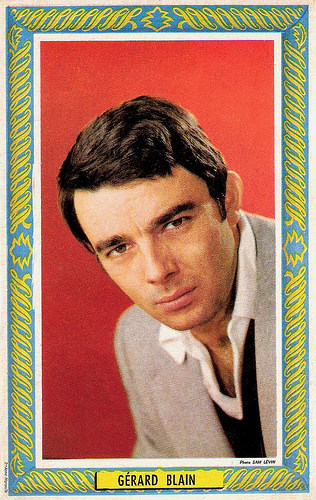
French postcard by St. Anne, Marseille. Photo: Sam Lévin.
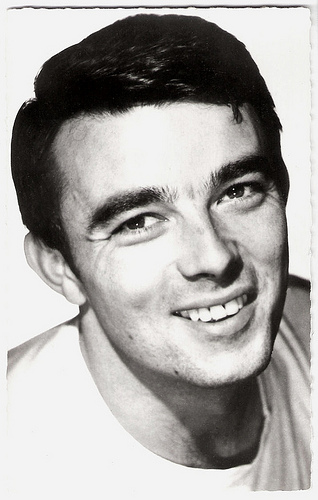
French postcard by Editions du Globe, Paris, no. 836. Photo: Sam Lévin.

French postcard by Editions P.I., Paris, no. 978. Offered by Les Carbones Korès 'Carboplane'. Photo: Sam Lévin.
Pretty Little Mouth
Gérard Ernest Zéphirin Blain was born in Paris, France in 1930. He was very young when his father, chief architect of the city of Paris, left the family home. The relations of Gerard with his mother and his sister became confrontational. At 13, he left school without even having the primary school certificate and began an eventful life among street children in the Paris of the Occupation.
This unhappy childhood would later become a recurring theme of his own films, including the highly autobiographical Un enfant dans la foule/A Child in the crowd (Gérard Blain, 1976).
He made his film debut with an uncredited bit part in Le Carrefour des enfants perdus/Children of Chaos (Leo Joannon, 1944) at the age of 13. In the following years he continued to work as an extra in Le Bal des passants/The ball of passers-by (Guillaume Radot, 1944), a melodrama about abortion starring Annie Ducaux , and the classic Les enfants du paradis/Children of the Paradise (Marcel Carné, 1944) with Arletty and Jean-Louis Barrault .
In 1944, he had a brief stay in the FFI (Forces Françaises de l'Intérieur), the French resistance. After the war, he lead a chaotic life and in 1953, he again began to play in such films as Les fruits sauvages/Wild Fruit (Hervé Bromberger, 1954), opposite his first wife Estella Blain , and Avant le deluge/Before the Deluge (André Cayatte, 1954) starring Marina Vlady .
Looking like a cross between Alain Delon and James Dean, he was noted for his ‘pretty little mouth.’ Finally director Julien Duvivier gave him his first substantial role in the thriller Voici le temps des assassins/Deadlier Than the Male (Julien Duvivier, 1956) as the son of Jean Gabin . It became his breakthrough in the cinema. Blain was 26 at the time.
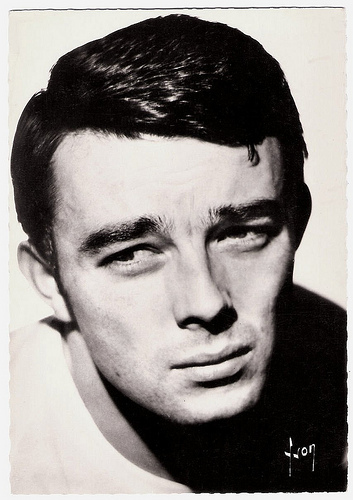
French postcard by Editions d'Art Yvon, Paris, no. 210. Photo: Sam Lévin.

Italian postcard by Bromofoto, Milano, no. 1732. Photo: Cineriz. Publicity still fort Via Margutta/Run with the Devil (Mario Camerini, 1960).
The Innocence of the Outsider
Gérard Blain met the directors of the Nouvelle Vague (the French New Wave) – Jean-Luc Godard, Claude Chabrol – who were born in the same year as he was. Quickly he became one of the faces of the Nouvelle Vague. Another Nouvelle Vague director, Francois Truffaut, engaged Blain for his second short film, Les Mistons/The Kids (Francois Truffaut, 1957), in which his co-star was his second wife, Bernadette Lafont . They played two lovers who are spied on by 5 kids, les mistons.
In 1958, Chabrol made him a Nouvelle Vague icon with his starring roles in Le Beau Serge/Beautiful Serge (Claude Chabrol, 1958) and Les Cousins/The Cousins (Claude Chabrol, 1958). His antagonist in both films was another face of the Nouvelle Vague, Jean-Claude Brialy .
At Films de France , James Travers writes: “Le Beau Serge brings together three of the actors who would become closely associated with the French New Wave: Jean-Claude Brialy, Gérard Blain and Bernadette Lafont. Whilst each of these actors gives a very credible performance, it is unquestionably Blain who has the greatest impact. Watching Blain in this film, it is hard not to recall James Dean in Rebel Without a Cause (1955). There is vitality and depth to his portrayal that makes him stand out from the film like a character in a children’s pop-up book, yet there is also wild quality that makes it difficult for us to sympathise with him. (Another feature of Chabrol’s cinema is its objectivity - we rarely, if ever, form any emotional attachment with the protagonists.) Blain’s bestial, child-like Serge makes a startling contrast with Brialy’s civilised man-of-the-world François - the difference in acting styles helps to emphasise the enormous gulf that exists between the two characters.”
About Les Cousins/The Cousins (1958), Travers writes: “Both of the two central characters, Charles and Paul, are played admirably by Gérard Blain and Jean-Claude Brialy. Blain manages to capture the innocence of the outsider and offers a sympathetic and memorable performance”.
Gérard Blain also worked with Godard at the short film Charlotte et son Jules/Charlotte and Her Boyfriend (Jean-Luc Godard, 1960) with Jean-Paul Belmondo . Later Jean-Pierre Mocky directed him in Les vierges/The Virgins (Jean-Pierre Mocky, 1962).
In Italy he also appeared regularly in films, including Giovani mariti/Young Husbands (Mauro Bolognini, 1958) with Isabelle Corey , I delfini/Silver Spoon Set (Francesco Maselli, 1960) opposite Claudia Cardinale , and the war drama Il gobbo/The Hunchback (Carlo Lizzani, 1961) with Anna-Maria Ferrero .
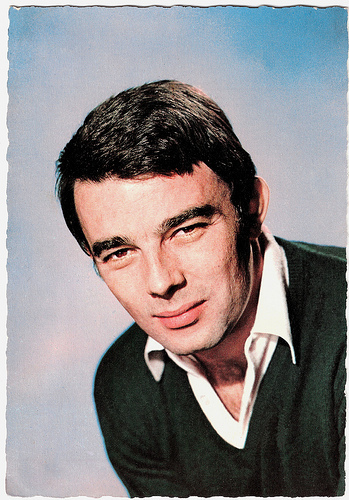
French postcard by E.D.U.G., no. 62. Photo: Sam Lévin.

French postcard by Editions P.I., Paris, no. FK 124. Photo: UFA.
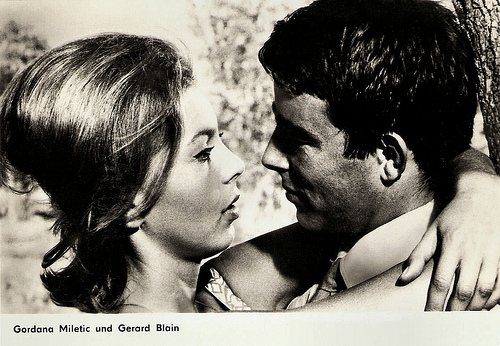
East-German postcard by VEB Progress Filmvertrieb, no. 2858, 1967. Photo: publicity still for Lo sgarro (Silvio Siano, 1962) with Gordana Miletic.
A Rebel Actor
In the early 1960s, Gérard Blain went to Hollywood to play alongside John Wayne in Hatari! (Howard Hawks, 1962). Blain was unable to adapt to the American star system, refused to sign a contract and returned to France. His ideas on cinema were against conformism. Blain was a rebel actor, morally uncompromising, constantly in revolt against his time.
He played less and smaller parts, but he continued to act in interesting films such as La Musica/The Music (Marguerite Duras, Paul Seban, 1966) with Delphine Seyrig, and Un homme de trop/Shock Troops (Costa Gravas, 1967) starring Charles Vanel .
He finally could express himself completely with his own film Les Amis/The Friends (Gérard Blain, 1971). His directorial début won the top prize at the Locarno Film Festival. He next directed himself and his two year old son Régis in Le pelican/The Pelican (Gérard Blain, 1974). It was nominated for the Golden Bear at the Berlin Film Festival.
Blain was a film purist, preferring amateurs to professional actors, against any artificial effect. His films are deeply influenced by director Robert Bresson, whom he admired. His directorial career produced a dozen films, two of which were selected for the Cannes Film Festival, but he never managed to get a real popular success.
According to French Wikipedia , Gérard Blain is considered by some as a ‘right-wing anarchist’ because of his unconventional ethics. At the Cannes Film Festival 1987, he created a controversy with the film Pierre et Djemila/Peter and Djemila (Gérard Blain, 1987), written with Michel Marmin and Mohamed Bouchibi.
While he directed he also continued to play in films by other directors. Among these films are Der amerikanische Freund/The American Friend (Wim Wenders, 1977), the crime film Poussière d'ange/Angel Dust (Edouard Niermans, 1987) starring Bernard Giraudeau, and his final film Bandits d'amour/Love Bandits (Pierre Le Bret, 2001).
At 70, Gérard Blain died of cancer in his hometown Paris in 2000. He had been married four times: he married and quickly divorced Micheline Estellat aka actress Estella Blain (1953-1956), actress Bernadette Lafont (1957-1959), and Monique Sobieski (1960-?). His fourth and final marriage was with Marie-Hélène Bauret (1985-2000) (his death). He had five sons from these marriages, of whom two died young. The others, Paul, Régis and Pierre, all worked with him on his films.
Trailer Les Cousins (1958). (No subtitles). Source: Eurekaentertainment (YouTube).
Trailer Le Beau Serge (1958). (No subtitles). Source: Gaumont (YouTube).
Trailer L'Oro di Roma (1961). (No subtitles). Source: EuroCineChannel-1 (YouTube).
Trailer Hatari! (1962). Source: ParamountmoviesDigital (YouTube).
Sources: James Travers (Films de France), Corentin Palanchini (AlloCiné) (French), Caroline Hanotte (CinéArtistes) (French), Cinememorial (French), Wikipedia (French) and .

French postcard by St. Anne, Marseille. Photo: Sam Lévin.

French postcard by Editions du Globe, Paris, no. 836. Photo: Sam Lévin.

French postcard by Editions P.I., Paris, no. 978. Offered by Les Carbones Korès 'Carboplane'. Photo: Sam Lévin.
Pretty Little Mouth
Gérard Ernest Zéphirin Blain was born in Paris, France in 1930. He was very young when his father, chief architect of the city of Paris, left the family home. The relations of Gerard with his mother and his sister became confrontational. At 13, he left school without even having the primary school certificate and began an eventful life among street children in the Paris of the Occupation.
This unhappy childhood would later become a recurring theme of his own films, including the highly autobiographical Un enfant dans la foule/A Child in the crowd (Gérard Blain, 1976).
He made his film debut with an uncredited bit part in Le Carrefour des enfants perdus/Children of Chaos (Leo Joannon, 1944) at the age of 13. In the following years he continued to work as an extra in Le Bal des passants/The ball of passers-by (Guillaume Radot, 1944), a melodrama about abortion starring Annie Ducaux , and the classic Les enfants du paradis/Children of the Paradise (Marcel Carné, 1944) with Arletty and Jean-Louis Barrault .
In 1944, he had a brief stay in the FFI (Forces Françaises de l'Intérieur), the French resistance. After the war, he lead a chaotic life and in 1953, he again began to play in such films as Les fruits sauvages/Wild Fruit (Hervé Bromberger, 1954), opposite his first wife Estella Blain , and Avant le deluge/Before the Deluge (André Cayatte, 1954) starring Marina Vlady .
Looking like a cross between Alain Delon and James Dean, he was noted for his ‘pretty little mouth.’ Finally director Julien Duvivier gave him his first substantial role in the thriller Voici le temps des assassins/Deadlier Than the Male (Julien Duvivier, 1956) as the son of Jean Gabin . It became his breakthrough in the cinema. Blain was 26 at the time.

French postcard by Editions d'Art Yvon, Paris, no. 210. Photo: Sam Lévin.

Italian postcard by Bromofoto, Milano, no. 1732. Photo: Cineriz. Publicity still fort Via Margutta/Run with the Devil (Mario Camerini, 1960).
The Innocence of the Outsider
Gérard Blain met the directors of the Nouvelle Vague (the French New Wave) – Jean-Luc Godard, Claude Chabrol – who were born in the same year as he was. Quickly he became one of the faces of the Nouvelle Vague. Another Nouvelle Vague director, Francois Truffaut, engaged Blain for his second short film, Les Mistons/The Kids (Francois Truffaut, 1957), in which his co-star was his second wife, Bernadette Lafont . They played two lovers who are spied on by 5 kids, les mistons.
In 1958, Chabrol made him a Nouvelle Vague icon with his starring roles in Le Beau Serge/Beautiful Serge (Claude Chabrol, 1958) and Les Cousins/The Cousins (Claude Chabrol, 1958). His antagonist in both films was another face of the Nouvelle Vague, Jean-Claude Brialy .
At Films de France , James Travers writes: “Le Beau Serge brings together three of the actors who would become closely associated with the French New Wave: Jean-Claude Brialy, Gérard Blain and Bernadette Lafont. Whilst each of these actors gives a very credible performance, it is unquestionably Blain who has the greatest impact. Watching Blain in this film, it is hard not to recall James Dean in Rebel Without a Cause (1955). There is vitality and depth to his portrayal that makes him stand out from the film like a character in a children’s pop-up book, yet there is also wild quality that makes it difficult for us to sympathise with him. (Another feature of Chabrol’s cinema is its objectivity - we rarely, if ever, form any emotional attachment with the protagonists.) Blain’s bestial, child-like Serge makes a startling contrast with Brialy’s civilised man-of-the-world François - the difference in acting styles helps to emphasise the enormous gulf that exists between the two characters.”
About Les Cousins/The Cousins (1958), Travers writes: “Both of the two central characters, Charles and Paul, are played admirably by Gérard Blain and Jean-Claude Brialy. Blain manages to capture the innocence of the outsider and offers a sympathetic and memorable performance”.
Gérard Blain also worked with Godard at the short film Charlotte et son Jules/Charlotte and Her Boyfriend (Jean-Luc Godard, 1960) with Jean-Paul Belmondo . Later Jean-Pierre Mocky directed him in Les vierges/The Virgins (Jean-Pierre Mocky, 1962).
In Italy he also appeared regularly in films, including Giovani mariti/Young Husbands (Mauro Bolognini, 1958) with Isabelle Corey , I delfini/Silver Spoon Set (Francesco Maselli, 1960) opposite Claudia Cardinale , and the war drama Il gobbo/The Hunchback (Carlo Lizzani, 1961) with Anna-Maria Ferrero .

French postcard by E.D.U.G., no. 62. Photo: Sam Lévin.

French postcard by Editions P.I., Paris, no. FK 124. Photo: UFA.

East-German postcard by VEB Progress Filmvertrieb, no. 2858, 1967. Photo: publicity still for Lo sgarro (Silvio Siano, 1962) with Gordana Miletic.
A Rebel Actor
In the early 1960s, Gérard Blain went to Hollywood to play alongside John Wayne in Hatari! (Howard Hawks, 1962). Blain was unable to adapt to the American star system, refused to sign a contract and returned to France. His ideas on cinema were against conformism. Blain was a rebel actor, morally uncompromising, constantly in revolt against his time.
He played less and smaller parts, but he continued to act in interesting films such as La Musica/The Music (Marguerite Duras, Paul Seban, 1966) with Delphine Seyrig, and Un homme de trop/Shock Troops (Costa Gravas, 1967) starring Charles Vanel .
He finally could express himself completely with his own film Les Amis/The Friends (Gérard Blain, 1971). His directorial début won the top prize at the Locarno Film Festival. He next directed himself and his two year old son Régis in Le pelican/The Pelican (Gérard Blain, 1974). It was nominated for the Golden Bear at the Berlin Film Festival.
Blain was a film purist, preferring amateurs to professional actors, against any artificial effect. His films are deeply influenced by director Robert Bresson, whom he admired. His directorial career produced a dozen films, two of which were selected for the Cannes Film Festival, but he never managed to get a real popular success.
According to French Wikipedia , Gérard Blain is considered by some as a ‘right-wing anarchist’ because of his unconventional ethics. At the Cannes Film Festival 1987, he created a controversy with the film Pierre et Djemila/Peter and Djemila (Gérard Blain, 1987), written with Michel Marmin and Mohamed Bouchibi.
While he directed he also continued to play in films by other directors. Among these films are Der amerikanische Freund/The American Friend (Wim Wenders, 1977), the crime film Poussière d'ange/Angel Dust (Edouard Niermans, 1987) starring Bernard Giraudeau, and his final film Bandits d'amour/Love Bandits (Pierre Le Bret, 2001).
At 70, Gérard Blain died of cancer in his hometown Paris in 2000. He had been married four times: he married and quickly divorced Micheline Estellat aka actress Estella Blain (1953-1956), actress Bernadette Lafont (1957-1959), and Monique Sobieski (1960-?). His fourth and final marriage was with Marie-Hélène Bauret (1985-2000) (his death). He had five sons from these marriages, of whom two died young. The others, Paul, Régis and Pierre, all worked with him on his films.
Trailer Les Cousins (1958). (No subtitles). Source: Eurekaentertainment (YouTube).
Trailer Le Beau Serge (1958). (No subtitles). Source: Gaumont (YouTube).
Trailer L'Oro di Roma (1961). (No subtitles). Source: EuroCineChannel-1 (YouTube).
Trailer Hatari! (1962). Source: ParamountmoviesDigital (YouTube).
Sources: James Travers (Films de France), Corentin Palanchini (AlloCiné) (French), Caroline Hanotte (CinéArtistes) (French), Cinememorial (French), Wikipedia (French) and .
Published on August 14, 2016 22:00
August 13, 2016
Madeleine Sologne
French stage and film actress Madeleine Sologne (1912-1995) was a popular star in the late 1930s and 1940s. She became the symbol for a generation when she appeared as a modern Isolde in Jean Cocteau’s L'Éternel Retour/The Eternal Return (1941). She and her film partner Jean Marais became the ideal couple of the European cinema of the 1940s. Girls did their hair in the long, blond Sologne fashion. But in 1948 the actress retired.
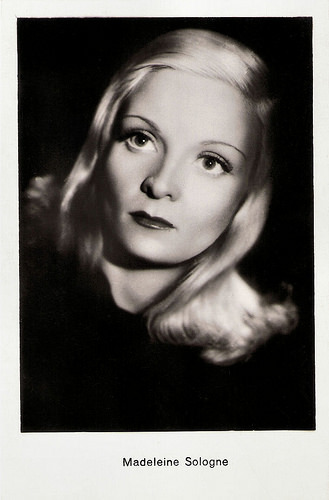
Czech postcard by Ceskoslevenske filmové nakladatelstvi, Praha, no. 15.

French postcard by Editions P.I., Paris, no. 45. Photo: Roger Carlet.
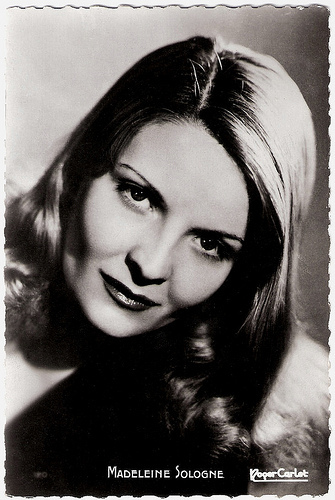
French postcard by Editions P.I., Paris, no. 120 (?). Photo: Roger Carlet.
The world Will Tremble
Madeleine Sologne was born as Madeleine Vouillon in the village La Ferte-Imbault in the region Sologne, France in 1912. She was the daughter of a poor tailor and she left her village after the death of her father.
At 16, she became an apprentice of Caroline Reboux, a famous hat designer in Paris. Next she opened her own millinery shop. In 1936, she married cinematographer Alain Douarinou. She also became the model of painter Mojzesz Kisling, who encouraged her to take acting lessons, with Julien Bertheau and Jacques Baumer.
Her first theatrical experience was in the play in Boccace, conte 19/Boccaccio tale 19 by Julien Luchaire. She made her film debut with a small role in the collective Popular Front propaganda film, La vie est à nous/Life is ours (Jean Renoir, Jean Boyer a.o., 1936). She continued to play small parts such as in Les gens du voyage/People Who Travel (Jacques Feyder, 1938).
In 1939, she rose to star status in Le monde tremblera/The world will tremble (Richard Pottier, 1939) next to Claude Dauphin and Erich von Stroheim . The screenplay, based on an obscure book, was written by Henri-Georges Clouzot, and tells about a machine that can tell you how many years, days, hours and minutes you have left to live.
She then appeared as the partner of Fernandel in the comedy Raphaël le tatoué/Raphael tattooed (Christian-Jaque, 1939), and her brown hair suited her well when she played a gypsy in Le Danube bleu/The Blue Danube (Emil E. Reinert, Alfred Rode, 1939) at the side of José Noguéro.
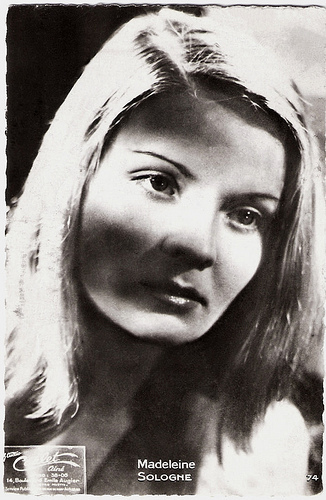
French postcard, no. 74. Photo: Roger Carlet.
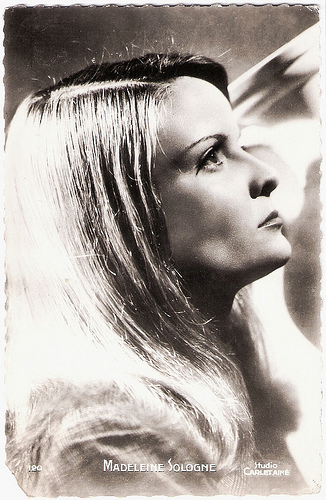
French postcard by Editions P.I., Paris, no. 120. Photo: Studio Carlet Ainé.

French postcard by Editions Publications Cinématographiques, no. 238.
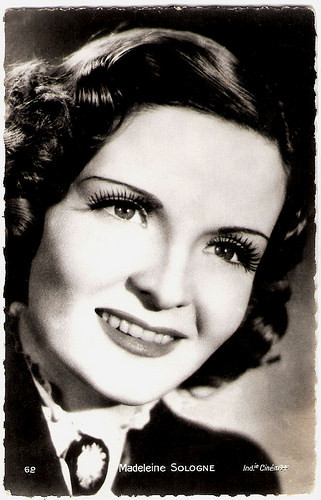
French postcard by Editions Chantal, Rueil (S.O.), no. 62. Photo: Ind.ie Ciném.que.
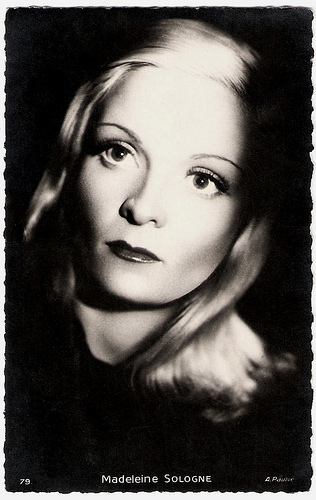
French postcard by Editions Chantal, Ruell-Malmaison, no. 79. Photo: A. Paulvé.
The Eternal Return
The German invasion in 1940 slowed down French film production, but the following year Madeleine Sologne starred in Fièvres/Fever (Jean Delannoy, 1941). In this film she played the wife of Tino Rossi , consumed by jealousy and dying of grief at her husband's infidelity. Another success was Le loup des Malveneur/The Wolf of Malveneur (Guillaume Radot, 1943) with Pierre Renoir .
Then the highlight of Sologne’s career came with the powerful romantic tragedy L'Éternel Retour/The Eternal Return (Jean Delannoy, 1943). The story, written by Jean Cocteau, is a modern update of the Tristan and Isolde legend. As the modern Tristan and Isolde, newcomer Jean Marais and Sologne are a stunningly handsome couple.
Sologne as blond Natalie had dyed her brown hair blond for the occasion, with a long falling lock à la Veronica Lake. The two lovers, symbolising the youth living under the yoke of the Nazi occupation, became mythical in the eyes of a generation.
In her obituary of Sologne in the British newspaper The Independent , Ginette Vincendeau writes: “The film is typical of the strong escapist trend in the cinema of the time which took its roots in history or legend - as did other films, such as Marcel Carné's Les Visiteurs du soir (1942) and Les Enfants du paradis (1943-45) - but paradoxically Sologne's success in it was due to her modern appearance.”
Both Sologne's smooth blond hairstyle and Marais' patterned jersey sweater, designed by the couturier Marcel Rochas (as were Sologne's clothes), were widely copied. Young girls did their hair ‘in the Madeleine Sologne fashion’.
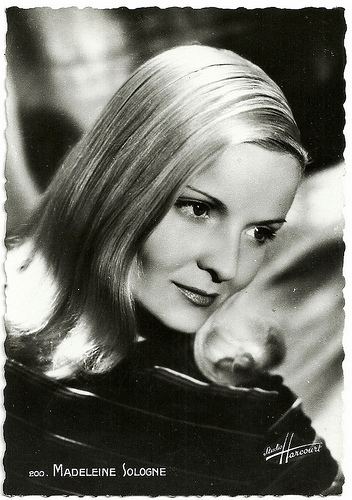
French postcard by Editions Greff, Paris, no. 200. Photo: Studio Harcourt.
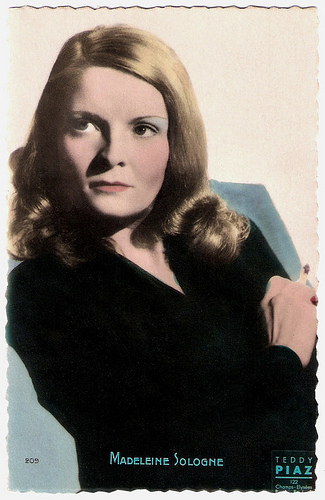
French postcard by Editions O.P., Paris, no. 209. Photo: Teddy Piaz.
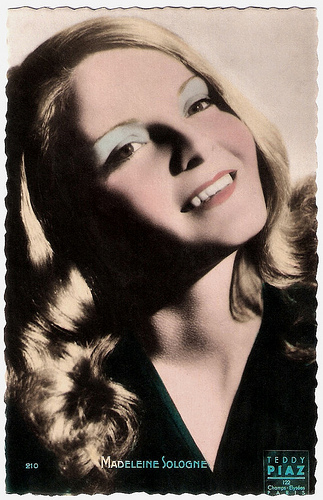
French postcard by Editions O.P., Paris, no. 210. Photo: Teddy Piaz.
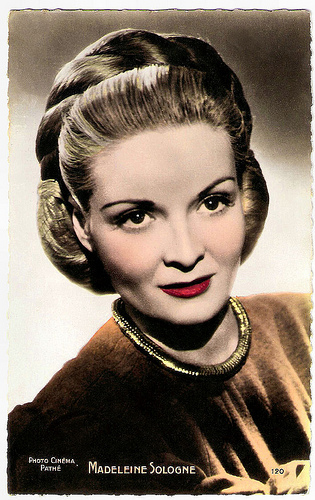
French postcard by Editions P.I., Paris, no. 120. Photo: Cinéma Pathé.
Swan Song
Her powerful mythical character in L'Éternel Retour/The Eternal Return (1943) and its popularity became paradoxically Madeleine Sologne’s swansong. After the war she returned in the lesser-known but fascinating La Foire aux chimères/Devil and the Angel (Pierre Chenal, 1946) co-starring Erich von Stroheim .
In a melodramatic reprise of Charles Chaplin 's City Lights story of 1931, Sologne plays a beautiful blind woman whose disfigured benefactor (Von Stroheim) goes mad and kills himself when she recovers her sight and leaves him.
Neither this nor her following films ever attained the popular or critical success of L'Eternel retour. After some minor roles, the actress retired in 1948.
During the 1950s she only appeared on stage, such as in La forêt pétrifiée/The Petrified Forest by Robert Emmet Sherwood, then in Aux quatre coins/The four corners by Jean Marsan and L'homme traqué/The hunted man by Francis Carco. She returned incidentally to the cinema, a last time for a small role in the crime drama Le Temps des loups/The Time of the Wolves (Sergio Gobbi, 1969) starring Robert Hossein .
She divorced Alain Douarinou and then married production manager Leopold Schlosberg. She regularly appeared on TV. After her second husband’s death in 1976, she returned to the region of her birth, Sologne. In 1995, Madeleine Sologne died in a nursing home in Vierzon, France. She was 82.
Scene from La Foire aux chimères/Devil and the Angel (Pierre Chenal, 1946) with Erich von Stroheim (no subtitles). Source: Richard Francomac (YouTube).
Scene from Fièvres/Fever (Jean Delannoy, 1941) with Tino Rossi . (No subtitles). Source: Jm Veynois (YouTube).
Another scene from Fièvres/Fever (Jean Delannoy, 1941) with Tino Rossi . (No subtitles). Source: Jm Veynois (YouTube).
Scene from L'Éternel Retour/The Eternal Return (1943) (No subtitles). Source: jean claude Deroudilhe (YouTube).
Sources: Caroline Hanotte (CinéArtistes), Ginette Vincendeau (The Independent), Lenin Imports, Wikipedia (French) and .

Czech postcard by Ceskoslevenske filmové nakladatelstvi, Praha, no. 15.

French postcard by Editions P.I., Paris, no. 45. Photo: Roger Carlet.

French postcard by Editions P.I., Paris, no. 120 (?). Photo: Roger Carlet.
The world Will Tremble
Madeleine Sologne was born as Madeleine Vouillon in the village La Ferte-Imbault in the region Sologne, France in 1912. She was the daughter of a poor tailor and she left her village after the death of her father.
At 16, she became an apprentice of Caroline Reboux, a famous hat designer in Paris. Next she opened her own millinery shop. In 1936, she married cinematographer Alain Douarinou. She also became the model of painter Mojzesz Kisling, who encouraged her to take acting lessons, with Julien Bertheau and Jacques Baumer.
Her first theatrical experience was in the play in Boccace, conte 19/Boccaccio tale 19 by Julien Luchaire. She made her film debut with a small role in the collective Popular Front propaganda film, La vie est à nous/Life is ours (Jean Renoir, Jean Boyer a.o., 1936). She continued to play small parts such as in Les gens du voyage/People Who Travel (Jacques Feyder, 1938).
In 1939, she rose to star status in Le monde tremblera/The world will tremble (Richard Pottier, 1939) next to Claude Dauphin and Erich von Stroheim . The screenplay, based on an obscure book, was written by Henri-Georges Clouzot, and tells about a machine that can tell you how many years, days, hours and minutes you have left to live.
She then appeared as the partner of Fernandel in the comedy Raphaël le tatoué/Raphael tattooed (Christian-Jaque, 1939), and her brown hair suited her well when she played a gypsy in Le Danube bleu/The Blue Danube (Emil E. Reinert, Alfred Rode, 1939) at the side of José Noguéro.

French postcard, no. 74. Photo: Roger Carlet.

French postcard by Editions P.I., Paris, no. 120. Photo: Studio Carlet Ainé.

French postcard by Editions Publications Cinématographiques, no. 238.

French postcard by Editions Chantal, Rueil (S.O.), no. 62. Photo: Ind.ie Ciném.que.

French postcard by Editions Chantal, Ruell-Malmaison, no. 79. Photo: A. Paulvé.
The Eternal Return
The German invasion in 1940 slowed down French film production, but the following year Madeleine Sologne starred in Fièvres/Fever (Jean Delannoy, 1941). In this film she played the wife of Tino Rossi , consumed by jealousy and dying of grief at her husband's infidelity. Another success was Le loup des Malveneur/The Wolf of Malveneur (Guillaume Radot, 1943) with Pierre Renoir .
Then the highlight of Sologne’s career came with the powerful romantic tragedy L'Éternel Retour/The Eternal Return (Jean Delannoy, 1943). The story, written by Jean Cocteau, is a modern update of the Tristan and Isolde legend. As the modern Tristan and Isolde, newcomer Jean Marais and Sologne are a stunningly handsome couple.
Sologne as blond Natalie had dyed her brown hair blond for the occasion, with a long falling lock à la Veronica Lake. The two lovers, symbolising the youth living under the yoke of the Nazi occupation, became mythical in the eyes of a generation.
In her obituary of Sologne in the British newspaper The Independent , Ginette Vincendeau writes: “The film is typical of the strong escapist trend in the cinema of the time which took its roots in history or legend - as did other films, such as Marcel Carné's Les Visiteurs du soir (1942) and Les Enfants du paradis (1943-45) - but paradoxically Sologne's success in it was due to her modern appearance.”
Both Sologne's smooth blond hairstyle and Marais' patterned jersey sweater, designed by the couturier Marcel Rochas (as were Sologne's clothes), were widely copied. Young girls did their hair ‘in the Madeleine Sologne fashion’.

French postcard by Editions Greff, Paris, no. 200. Photo: Studio Harcourt.

French postcard by Editions O.P., Paris, no. 209. Photo: Teddy Piaz.

French postcard by Editions O.P., Paris, no. 210. Photo: Teddy Piaz.

French postcard by Editions P.I., Paris, no. 120. Photo: Cinéma Pathé.
Swan Song
Her powerful mythical character in L'Éternel Retour/The Eternal Return (1943) and its popularity became paradoxically Madeleine Sologne’s swansong. After the war she returned in the lesser-known but fascinating La Foire aux chimères/Devil and the Angel (Pierre Chenal, 1946) co-starring Erich von Stroheim .
In a melodramatic reprise of Charles Chaplin 's City Lights story of 1931, Sologne plays a beautiful blind woman whose disfigured benefactor (Von Stroheim) goes mad and kills himself when she recovers her sight and leaves him.
Neither this nor her following films ever attained the popular or critical success of L'Eternel retour. After some minor roles, the actress retired in 1948.
During the 1950s she only appeared on stage, such as in La forêt pétrifiée/The Petrified Forest by Robert Emmet Sherwood, then in Aux quatre coins/The four corners by Jean Marsan and L'homme traqué/The hunted man by Francis Carco. She returned incidentally to the cinema, a last time for a small role in the crime drama Le Temps des loups/The Time of the Wolves (Sergio Gobbi, 1969) starring Robert Hossein .
She divorced Alain Douarinou and then married production manager Leopold Schlosberg. She regularly appeared on TV. After her second husband’s death in 1976, she returned to the region of her birth, Sologne. In 1995, Madeleine Sologne died in a nursing home in Vierzon, France. She was 82.
Scene from La Foire aux chimères/Devil and the Angel (Pierre Chenal, 1946) with Erich von Stroheim (no subtitles). Source: Richard Francomac (YouTube).
Scene from Fièvres/Fever (Jean Delannoy, 1941) with Tino Rossi . (No subtitles). Source: Jm Veynois (YouTube).
Another scene from Fièvres/Fever (Jean Delannoy, 1941) with Tino Rossi . (No subtitles). Source: Jm Veynois (YouTube).
Scene from L'Éternel Retour/The Eternal Return (1943) (No subtitles). Source: jean claude Deroudilhe (YouTube).
Sources: Caroline Hanotte (CinéArtistes), Ginette Vincendeau (The Independent), Lenin Imports, Wikipedia (French) and .
Published on August 13, 2016 22:00
August 12, 2016
Jessie Matthews
Saucer-eyed, long-legged Jessie Matthews (1907-1981) was a gamine, graceful dancer, with a sweet, pure-toned singing voice, and waif-like sex appeal. She embodied 1930s style. For most of the decade, she was the most popular musical star in England, and ranked on a par with Fred Astaire, Ruby Keeler, and Ginger Rogers. She was a favourite of Irving Berlin and Richard Rodgers & Lorenz Hart, all of whom gave her some of their very best work. Her personal life was blighted by relationship breakdowns and her struggles against ill-health and insecurity.
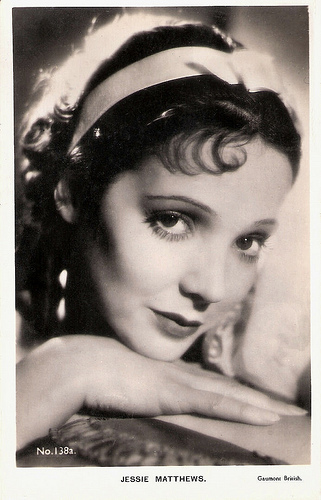
British postcard in the Film-Kurier series, London, no. 138a. Sent by mail in Great-Britain in 1937. Photo: Gaumont British.

British collectors card by De Reszke Cigarettes, no. 9. Photo: Gaumont-British.
Dancing on the Ceiling
Jessie Margaret Matthews was born in Soho, London, in 1907, in relative poverty. She was the seventh of sixteen children (of whom eleven survived) of a fruit-and-vegetable seller. Matthews enjoyed dancing from an early age, and elocution lessons created her distinctive ‘plummy’ accent.
Aged 12, she debuted on stage as a child dancer in Bluebell in Fairyland (1919) by Seymour Hicks , at the Metropolitan Music Hall in London. She made her West End debut at 16 in Irving Berlin's Music Box Revue.
Her first film appearance was in the silent film The Beloved Vagabond (Fred LeRoy Granville, 1923). More fleeting dancing roles in silent films followed. Matthews was in the chorus of Charlot Review (1926) in London, and went with the show to New York, where she was also understudy to the star, Gertrude Lawrence. When Lawrence fell ill, Matthews took over the role and was given great reviews.
Matthews was acclaimed in the United Kingdom as a dancer and as the first performer of numerous popular songs of the 1920s and 1930s, including A Room with a View and London Calling! by Noël Coward and Let's Do It, Let's Fall in Love by Cole Porter. In London, she was in Ever Green (1930), a musical by Rodgers and Hart that was partly inspired by the life of music hall star Marie Lloyd.
At its time Ever Green was the most expensive musical ever mounted on a London stage. It featured the hit song Dancing on the Ceiling. Matthews co-starred with Sonnie Hale (then husband of Evelyn Laye ) which led to a scandalous divorce action, Matthews cited as the ‘other woman’. The scandal should have kept Matthews off the screen but the talkies needed musical stars and Matthews clicked big-time in films like Out of the Blue (Gene Gerrard, J.O.C. Orton, 1931), There Goes the Bride (Albert de Courville, 1932) opposite Owen Nares , and The Man from Toronto (Sinclair Hill, 1933).
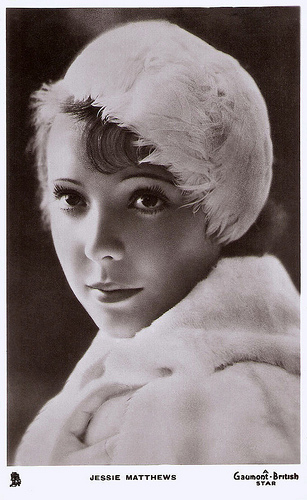
British postcard by Raphael Tuck & Sons in the Real Photograph series, no. 66-S. Photo: Gaumont-British.
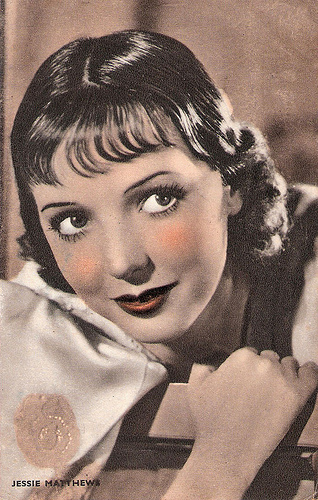
Vintage postcard.
Dancing With Airy Grace and Fluidity
Jessie Matthews’ fame reached its initial height with her breakthrough film performance as Susie Dean, dancing with airy grace and fluidity, in the film of J.B. Priestley's novel, The Good Companions (1933), for Victor Saville, her most sympathetic director.
The film is about three musicians (including John Gielgud in his first film and Edmund Gwenn ) joining together to save a failing concert party, the Dinky Doos.
At IMDb , Bensonj reviews: “Jessie Matthews' ability and magnetism are so evident there's just no question that when the right person finally sees her perform her star quality will be instantly recognized. This was never more true than in The Good Companions, where Matthews' vitality, youth, sex appeal and talent absolutely light up the film! Like every aspect of this film, the romance between Gielgud and Matthews is remarkable to behold. She's so strong willed, so incandescent, Gielgud seems almost afraid to burn his fingers, yet dares to hold his own. As with only the finest fairy tale fantasies, this is absolutely grounded in the real world, filled with sharp, rich characterizations and the details of its time and place.”
She then appeared in Friday the Thirteenth (Victor Saville, 1933) opposite Sonnie Hale, and the flop Waltzes from Vienna (Alfred Hitchcock, 1934) about the lives of Johann Strauss the elder ( Edmund Gwenn ) and younger (Esmond Knight).
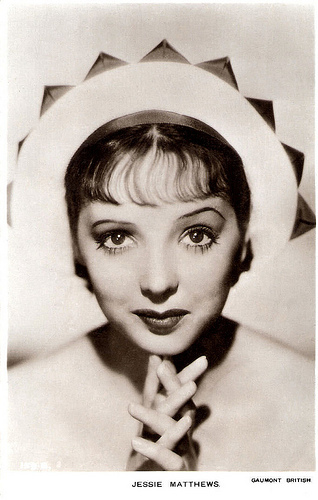
British postcard, no. 159b. Photo: Gaumont British.
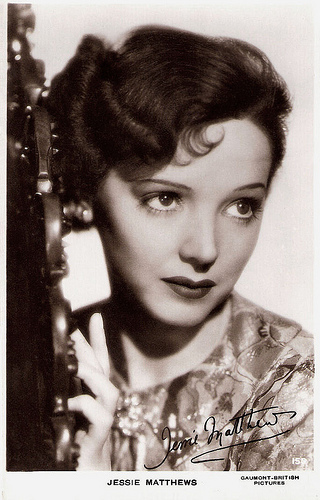
British postcard by Real Photograph, no. 159. Photo: Gaumont-British Pictures.
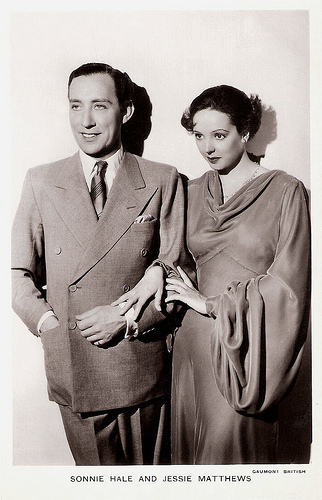
British postcard in the Film Partners series, London, no. P 196. Photo: Gaumont British.
Gender-swapping Musical Comedy
That same year, Jessie Matthews’ biggest film triumph followed: the film version of Evergreen (Victor Saville, 1934) with Sonnie Hale and Betty Balfour . At IMDb , bbrntwist reviews: “This is an utterly charming and delightful film, derived from the London production of a Rodgers and Hart musical. (...) Matthews is a sheer delight, reminding me of Joan Collins , Julie Andrews , Jane Wyatt and Jennifer Jones, all rolled into one.”
The film opened in the USA at Radio City Music Hall, New York, and Matthews was labelled ‘The Dancing Divinity’, although attempts to co-star her and Fred Astaire in a film never materialised. Her British studio (Gaumont British) was reluctant to let go of its biggest name, which resulted in offers for her to work in Hollywood being repeatedly rejected.
Evergreen (1934) featured the newly composed song Over My Shoulder which would become Matthews' personal theme song, later giving its title to her 1974 autobiography and to a 21st-century musical stage show of her life.
Next came the gender-swapping musical comedy First A Girl (Victor Saville, 1935). It was later remade as Victor, Victoria (Blake Edwards, 1982) starring Julie Andrews . Like all of Matthews major 1930s films, it was produced by Gaumont British, which surrounded her with the best available talent.
Other, weaker films were directed by Sonnie Hale, including Head over Heels (Sonnie Hale, 1937) with Louis Borel , and Sailing Along (Sonnie Hale, 1938) with Roland Young. In Climbing High (Carol Reed, 1938), Matthews costarred with Michael Redgrave . During the shooting, Matthews and Carol Reed had a brief affair.
Her only US film role was a cameo in the all-star fundraiser Forever and a Day (René Clair, 1943). Roger Phillip Mellor writes in the Encyclopedia of British Cinema : “For most of the 1930s, Matthews was the most popular female film star in England: the image of her in Sailing Along (Sonnie Hale, 1938), in a white evening gown, with a gentleman's black top hat and walking cane, performing Souvenir of Love in Lime Grove's art deco luxury sets, indelibly incarnates 1930s style.”
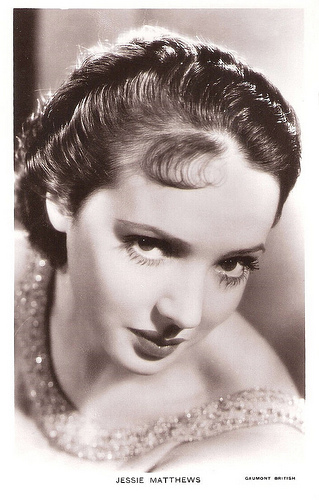
British postcard in the Picturegoer series, London, no. 711a. Photo: Gaumont British.
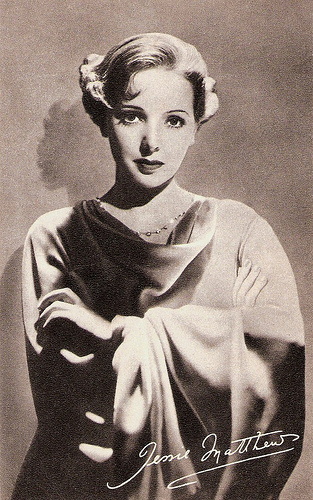
British postcard by Real Photogravure. Photo: Gaumont British.
Nice Middle-class Doctor's Wife
Jessie Matthews’ distinctive warbling voice and round cheeks made her a familiar and much-loved personality to British theatre and film audiences at the beginning of World War II, but her popularity waned in the 1940s after several years' absence from the screen followed by an unsatisfactory thriller, Candles at Nine (John Harlow, 1944).
Post-war audiences associated her with a world of hectic pre-war luxury that was now seen as obsolete in austerity-era Britain. After a few false starts as a straight actress she played Tom Thumb's mother in the children's film Tom Thumb (George Pal, 1958).
During the 1960s she found new fame when she took over the leading role of Mary Dale in the hugely popular BBC radio show, The Dales, formerly Mrs Dale's Diary. The title character was a nice middle-class doctor's wife, Mary, and her husband Jim who lived at Virginia Lodge in the Middlesex suburb of Parkwood Hill.
Live theatre and variety shows remained the mainstay of Matthews' work through the 1950s and 1960s, with successful tours of Australia and South Africa interspersed with periods of less glamorous but welcome work in British provincial theatre and pantomimes.
Matthews was awarded an OBE in 1970 and became a stalwart nostalgia feature of TV variety shows such as The Night Of A Thousand Stars and The Good Old Days. She returned to the stage in 1973 in an acclaimed performance in Charles Kingsley's The Water Babies. Her television appearances also included one-off guest roles in the popular BBC series Angels (1976) and an episode of the ITV mystery anthology Tales of the Unexpected (1980).
She was perfectly cast as Aunt Bessie in the mini-series Edward and Mrs. Simpson (Waris Hussein, 1978) starring Edward Fox. The following year she took her one-woman stage show to Los Angeles and won the United States Drama Logue Award 1979 for the year's best performance in concert. Her last film role was in the horror comedy The Hound of the Baskervilles (Paul Morrissey, 1978) starring Peter Cook and Dudley Moore.
Jessie Matthews was married three times. In 1926 she married actor Henry Lytton, Jr. They divorced in 1929. The second marriage was to Sonnie Hale (1931-1944); the third to military officer, Lt. Brian Lewis (1945-1959). All of her marriages ended in divorce and were marred by affairs and a series of unsuccessful pregnancies. With Hale she had one adopted daughter, Catherine Hale-Monro. Jessie Matthews had suffered from periods of ill-health throughout her life and eventually died of cancer in 1981 in Eastcote, England. She was 74.
At British Pictures , David Absalom remembers: “Her films were fluff, but unlike her musical-comedy rivals ( Gracie Fields and George Formby ), she had grace and glamour. Her costumes were carefully designed to show off as much of her body as the censor would allow, and her dancing can best be described as a high-class bump and grind act. No other star had that fluidity of movement and that joie de vivre.”
Scene from The Good Companions (1933) with John Gielgud, Max Miller and Jessie Matthews. Source: Art Deco Chap (YouTube).
Jessie Matthews sings Over My Shoulder in Evergreen (1934). Source: Other-Pete (YouTube).
Scene from Gangway (1937). Source: Guggle 86 (YouTube).
Trailer Tom Thumb (1958). Source: Video Detective (YouTube).
Sources: Roger Phillip Mellor (Encyclopedia of British Cinema), David Absalom (British Pictures), Bruce Eder (AllMovie), Michael Thornton (Daily Mail), (IMDb), Wikipedia, and .

British postcard in the Film-Kurier series, London, no. 138a. Sent by mail in Great-Britain in 1937. Photo: Gaumont British.

British collectors card by De Reszke Cigarettes, no. 9. Photo: Gaumont-British.
Dancing on the Ceiling
Jessie Margaret Matthews was born in Soho, London, in 1907, in relative poverty. She was the seventh of sixteen children (of whom eleven survived) of a fruit-and-vegetable seller. Matthews enjoyed dancing from an early age, and elocution lessons created her distinctive ‘plummy’ accent.
Aged 12, she debuted on stage as a child dancer in Bluebell in Fairyland (1919) by Seymour Hicks , at the Metropolitan Music Hall in London. She made her West End debut at 16 in Irving Berlin's Music Box Revue.
Her first film appearance was in the silent film The Beloved Vagabond (Fred LeRoy Granville, 1923). More fleeting dancing roles in silent films followed. Matthews was in the chorus of Charlot Review (1926) in London, and went with the show to New York, where she was also understudy to the star, Gertrude Lawrence. When Lawrence fell ill, Matthews took over the role and was given great reviews.
Matthews was acclaimed in the United Kingdom as a dancer and as the first performer of numerous popular songs of the 1920s and 1930s, including A Room with a View and London Calling! by Noël Coward and Let's Do It, Let's Fall in Love by Cole Porter. In London, she was in Ever Green (1930), a musical by Rodgers and Hart that was partly inspired by the life of music hall star Marie Lloyd.
At its time Ever Green was the most expensive musical ever mounted on a London stage. It featured the hit song Dancing on the Ceiling. Matthews co-starred with Sonnie Hale (then husband of Evelyn Laye ) which led to a scandalous divorce action, Matthews cited as the ‘other woman’. The scandal should have kept Matthews off the screen but the talkies needed musical stars and Matthews clicked big-time in films like Out of the Blue (Gene Gerrard, J.O.C. Orton, 1931), There Goes the Bride (Albert de Courville, 1932) opposite Owen Nares , and The Man from Toronto (Sinclair Hill, 1933).

British postcard by Raphael Tuck & Sons in the Real Photograph series, no. 66-S. Photo: Gaumont-British.

Vintage postcard.
Dancing With Airy Grace and Fluidity
Jessie Matthews’ fame reached its initial height with her breakthrough film performance as Susie Dean, dancing with airy grace and fluidity, in the film of J.B. Priestley's novel, The Good Companions (1933), for Victor Saville, her most sympathetic director.
The film is about three musicians (including John Gielgud in his first film and Edmund Gwenn ) joining together to save a failing concert party, the Dinky Doos.
At IMDb , Bensonj reviews: “Jessie Matthews' ability and magnetism are so evident there's just no question that when the right person finally sees her perform her star quality will be instantly recognized. This was never more true than in The Good Companions, where Matthews' vitality, youth, sex appeal and talent absolutely light up the film! Like every aspect of this film, the romance between Gielgud and Matthews is remarkable to behold. She's so strong willed, so incandescent, Gielgud seems almost afraid to burn his fingers, yet dares to hold his own. As with only the finest fairy tale fantasies, this is absolutely grounded in the real world, filled with sharp, rich characterizations and the details of its time and place.”
She then appeared in Friday the Thirteenth (Victor Saville, 1933) opposite Sonnie Hale, and the flop Waltzes from Vienna (Alfred Hitchcock, 1934) about the lives of Johann Strauss the elder ( Edmund Gwenn ) and younger (Esmond Knight).

British postcard, no. 159b. Photo: Gaumont British.

British postcard by Real Photograph, no. 159. Photo: Gaumont-British Pictures.

British postcard in the Film Partners series, London, no. P 196. Photo: Gaumont British.
Gender-swapping Musical Comedy
That same year, Jessie Matthews’ biggest film triumph followed: the film version of Evergreen (Victor Saville, 1934) with Sonnie Hale and Betty Balfour . At IMDb , bbrntwist reviews: “This is an utterly charming and delightful film, derived from the London production of a Rodgers and Hart musical. (...) Matthews is a sheer delight, reminding me of Joan Collins , Julie Andrews , Jane Wyatt and Jennifer Jones, all rolled into one.”
The film opened in the USA at Radio City Music Hall, New York, and Matthews was labelled ‘The Dancing Divinity’, although attempts to co-star her and Fred Astaire in a film never materialised. Her British studio (Gaumont British) was reluctant to let go of its biggest name, which resulted in offers for her to work in Hollywood being repeatedly rejected.
Evergreen (1934) featured the newly composed song Over My Shoulder which would become Matthews' personal theme song, later giving its title to her 1974 autobiography and to a 21st-century musical stage show of her life.
Next came the gender-swapping musical comedy First A Girl (Victor Saville, 1935). It was later remade as Victor, Victoria (Blake Edwards, 1982) starring Julie Andrews . Like all of Matthews major 1930s films, it was produced by Gaumont British, which surrounded her with the best available talent.
Other, weaker films were directed by Sonnie Hale, including Head over Heels (Sonnie Hale, 1937) with Louis Borel , and Sailing Along (Sonnie Hale, 1938) with Roland Young. In Climbing High (Carol Reed, 1938), Matthews costarred with Michael Redgrave . During the shooting, Matthews and Carol Reed had a brief affair.
Her only US film role was a cameo in the all-star fundraiser Forever and a Day (René Clair, 1943). Roger Phillip Mellor writes in the Encyclopedia of British Cinema : “For most of the 1930s, Matthews was the most popular female film star in England: the image of her in Sailing Along (Sonnie Hale, 1938), in a white evening gown, with a gentleman's black top hat and walking cane, performing Souvenir of Love in Lime Grove's art deco luxury sets, indelibly incarnates 1930s style.”

British postcard in the Picturegoer series, London, no. 711a. Photo: Gaumont British.

British postcard by Real Photogravure. Photo: Gaumont British.
Nice Middle-class Doctor's Wife
Jessie Matthews’ distinctive warbling voice and round cheeks made her a familiar and much-loved personality to British theatre and film audiences at the beginning of World War II, but her popularity waned in the 1940s after several years' absence from the screen followed by an unsatisfactory thriller, Candles at Nine (John Harlow, 1944).
Post-war audiences associated her with a world of hectic pre-war luxury that was now seen as obsolete in austerity-era Britain. After a few false starts as a straight actress she played Tom Thumb's mother in the children's film Tom Thumb (George Pal, 1958).
During the 1960s she found new fame when she took over the leading role of Mary Dale in the hugely popular BBC radio show, The Dales, formerly Mrs Dale's Diary. The title character was a nice middle-class doctor's wife, Mary, and her husband Jim who lived at Virginia Lodge in the Middlesex suburb of Parkwood Hill.
Live theatre and variety shows remained the mainstay of Matthews' work through the 1950s and 1960s, with successful tours of Australia and South Africa interspersed with periods of less glamorous but welcome work in British provincial theatre and pantomimes.
Matthews was awarded an OBE in 1970 and became a stalwart nostalgia feature of TV variety shows such as The Night Of A Thousand Stars and The Good Old Days. She returned to the stage in 1973 in an acclaimed performance in Charles Kingsley's The Water Babies. Her television appearances also included one-off guest roles in the popular BBC series Angels (1976) and an episode of the ITV mystery anthology Tales of the Unexpected (1980).
She was perfectly cast as Aunt Bessie in the mini-series Edward and Mrs. Simpson (Waris Hussein, 1978) starring Edward Fox. The following year she took her one-woman stage show to Los Angeles and won the United States Drama Logue Award 1979 for the year's best performance in concert. Her last film role was in the horror comedy The Hound of the Baskervilles (Paul Morrissey, 1978) starring Peter Cook and Dudley Moore.
Jessie Matthews was married three times. In 1926 she married actor Henry Lytton, Jr. They divorced in 1929. The second marriage was to Sonnie Hale (1931-1944); the third to military officer, Lt. Brian Lewis (1945-1959). All of her marriages ended in divorce and were marred by affairs and a series of unsuccessful pregnancies. With Hale she had one adopted daughter, Catherine Hale-Monro. Jessie Matthews had suffered from periods of ill-health throughout her life and eventually died of cancer in 1981 in Eastcote, England. She was 74.
At British Pictures , David Absalom remembers: “Her films were fluff, but unlike her musical-comedy rivals ( Gracie Fields and George Formby ), she had grace and glamour. Her costumes were carefully designed to show off as much of her body as the censor would allow, and her dancing can best be described as a high-class bump and grind act. No other star had that fluidity of movement and that joie de vivre.”
Scene from The Good Companions (1933) with John Gielgud, Max Miller and Jessie Matthews. Source: Art Deco Chap (YouTube).
Jessie Matthews sings Over My Shoulder in Evergreen (1934). Source: Other-Pete (YouTube).
Scene from Gangway (1937). Source: Guggle 86 (YouTube).
Trailer Tom Thumb (1958). Source: Video Detective (YouTube).
Sources: Roger Phillip Mellor (Encyclopedia of British Cinema), David Absalom (British Pictures), Bruce Eder (AllMovie), Michael Thornton (Daily Mail), (IMDb), Wikipedia, and .
Published on August 12, 2016 22:00
August 11, 2016
EFSP's Dazzling Dozen: New from GDI
In the Dutch village of Noord-Scharwoude is a small but dynamic Filmmuseum, the Geoffrey Donaldson Institute (GDI). Director is our friend Egbert Barten who always shares his new postcard acquisitions with EFSP. His latest acquisition is a collection of postcards of female stars from the early 1960s. In colour or in black and white, from European and Hollywood stars, published in the Netherlands and in Germany - and one in Italy. Many were sent by mail to a film fan in the village of Helden in the south of the Netherlands. We selected 12 postcards to give an impression which film actresses dazzled a Dutch film fan in 1962.
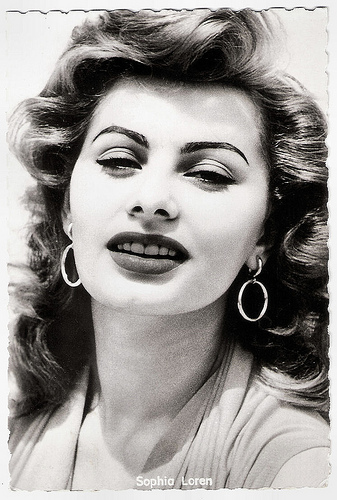
Sophia Loren . German postcard by Kolibri-Verlag G.m.b.H, Minden/Westf. Sent by mail in the Netherlands in 1962. Collection: Geoffrey Donaldson Institute.
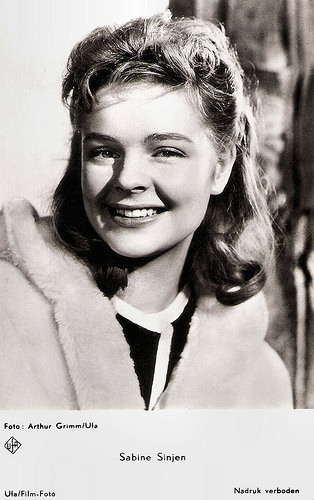
Sabine Sinjen . Dutch postcard by Gebr. Spanjersberg N.V., Rotterdam, no. 4788. Sent by mail in the Netherlands in 1962. Photo: Arthur Grimm / Ufa. Collection: Geoffrey Donaldson Institute.
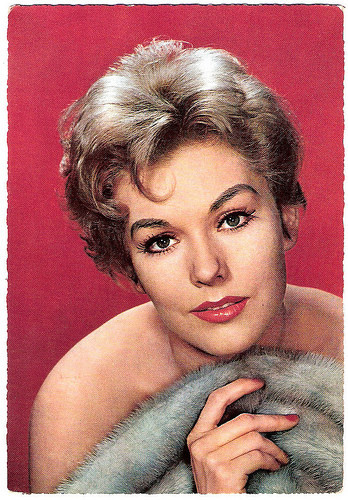
Kim Novak . German postcard by Krüger, no. 902/26. Sent by mail in the Netherlands in 1963. Collection: Geoffrey Donaldson Institute.
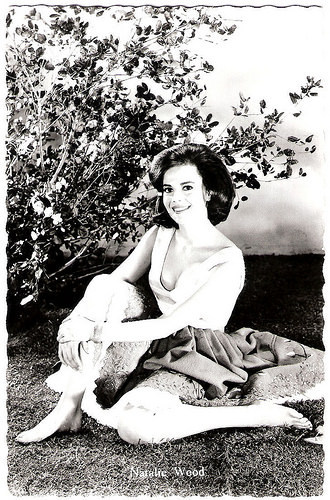
Natalie Wood. Dutch postcard. Sent by mail in the Netherlands in 1962. Publicity still for Splendor in the Grass (Elia Kazan, 1961). Collection: Geoffrey Donaldson Institute.
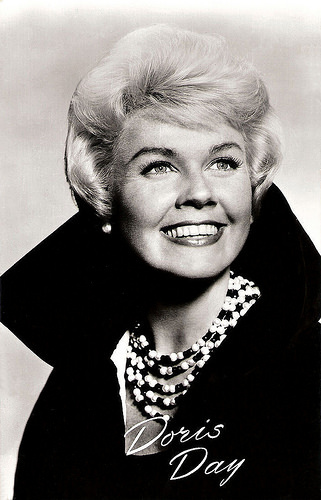
Doris Day. Dutch postcard by Uitg. Takken, Utrecht, no. AX 4240. Photo: Universal International. Publicity still for Pillow Talk (Michael Gordon, 1959). Collection: Geoffrey Donaldson Institute.
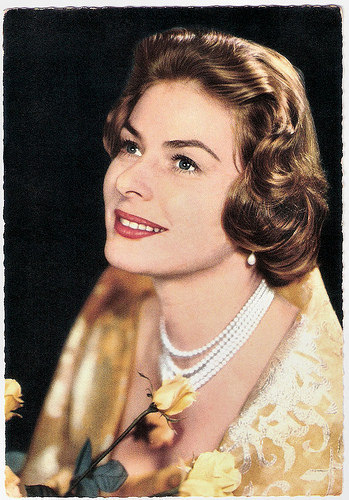
Ingrid Bergman . German postcard by ISV, no. H 21. Sent by mail in the Netherlands in 1962. Collection: Geoffrey Donaldson Institute.
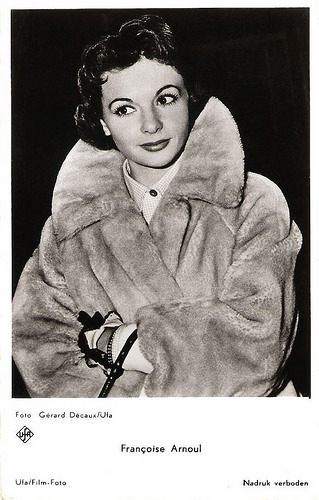
Françoise Arnoul . Dutch postcard by Gebr. Spanjersberg N.V., Rotterdam, no. 3318. Photo: Gérard Décaux / Ufa. Collection: Geoffrey Donaldson Institute.
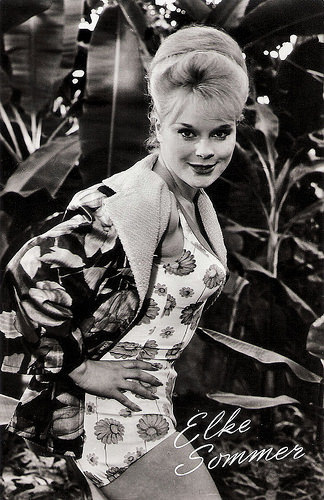
Elke Sommer . Dutch postcard by Uitg. Takken, Utrecht, no. AX 4982. Collection: Geoffrey Donaldson Institute.
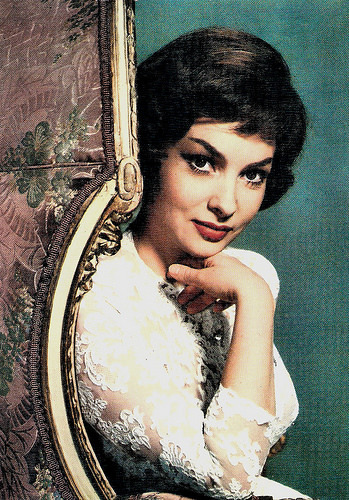
Gina Lollobrigida . Italian postcard by Rotalfoto, Milano, no. 93. Sent by mail in the Netherlands in 1962. Collection: Geoffrey Donaldson Institute.
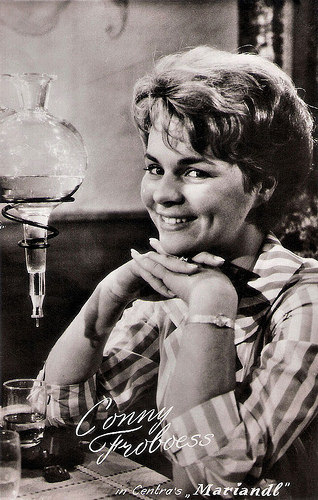
Conny Froboess . Dutch postcard by Takken, Utrecht, no. AX 4892. Photo: Centrafilm. Publicity still for Mariandl (Werner Jacobs, 1961). Collection: Geoffrey Donaldson Institute.
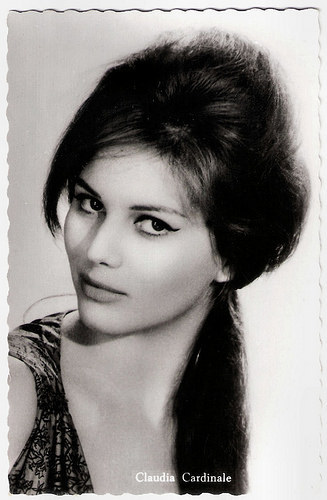
Claudia Cardinale . Dutch postcard. Collection: Geoffrey Donaldson Institute.
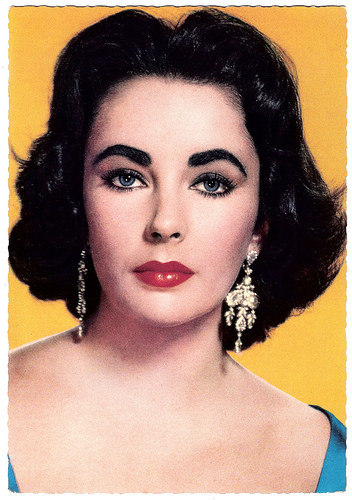
Elizabeth Taylor . German postcard by ISV, no. B 23. Photo: MGM. Publicity still for Cat on a Hot Tin Roof (Richard Brooks, 1958). Collection: Geoffrey Donaldson Institute.
Thanks, Egbert!
This is a post for Postcard Friendship Friday, hosted by Beth at the The Best Hearts are Crunchy. You can visit her by clicking on the button below.


Sophia Loren . German postcard by Kolibri-Verlag G.m.b.H, Minden/Westf. Sent by mail in the Netherlands in 1962. Collection: Geoffrey Donaldson Institute.

Sabine Sinjen . Dutch postcard by Gebr. Spanjersberg N.V., Rotterdam, no. 4788. Sent by mail in the Netherlands in 1962. Photo: Arthur Grimm / Ufa. Collection: Geoffrey Donaldson Institute.

Kim Novak . German postcard by Krüger, no. 902/26. Sent by mail in the Netherlands in 1963. Collection: Geoffrey Donaldson Institute.

Natalie Wood. Dutch postcard. Sent by mail in the Netherlands in 1962. Publicity still for Splendor in the Grass (Elia Kazan, 1961). Collection: Geoffrey Donaldson Institute.

Doris Day. Dutch postcard by Uitg. Takken, Utrecht, no. AX 4240. Photo: Universal International. Publicity still for Pillow Talk (Michael Gordon, 1959). Collection: Geoffrey Donaldson Institute.

Ingrid Bergman . German postcard by ISV, no. H 21. Sent by mail in the Netherlands in 1962. Collection: Geoffrey Donaldson Institute.

Françoise Arnoul . Dutch postcard by Gebr. Spanjersberg N.V., Rotterdam, no. 3318. Photo: Gérard Décaux / Ufa. Collection: Geoffrey Donaldson Institute.

Elke Sommer . Dutch postcard by Uitg. Takken, Utrecht, no. AX 4982. Collection: Geoffrey Donaldson Institute.

Gina Lollobrigida . Italian postcard by Rotalfoto, Milano, no. 93. Sent by mail in the Netherlands in 1962. Collection: Geoffrey Donaldson Institute.

Conny Froboess . Dutch postcard by Takken, Utrecht, no. AX 4892. Photo: Centrafilm. Publicity still for Mariandl (Werner Jacobs, 1961). Collection: Geoffrey Donaldson Institute.

Claudia Cardinale . Dutch postcard. Collection: Geoffrey Donaldson Institute.

Elizabeth Taylor . German postcard by ISV, no. B 23. Photo: MGM. Publicity still for Cat on a Hot Tin Roof (Richard Brooks, 1958). Collection: Geoffrey Donaldson Institute.
Thanks, Egbert!
This is a post for Postcard Friendship Friday, hosted by Beth at the The Best Hearts are Crunchy. You can visit her by clicking on the button below.

Published on August 11, 2016 22:00
Paul van Yperen's Blog
- Paul van Yperen's profile
- 13 followers
Paul van Yperen isn't a Goodreads Author
(yet),
but they
do have a blog,
so here are some recent posts imported from
their feed.



